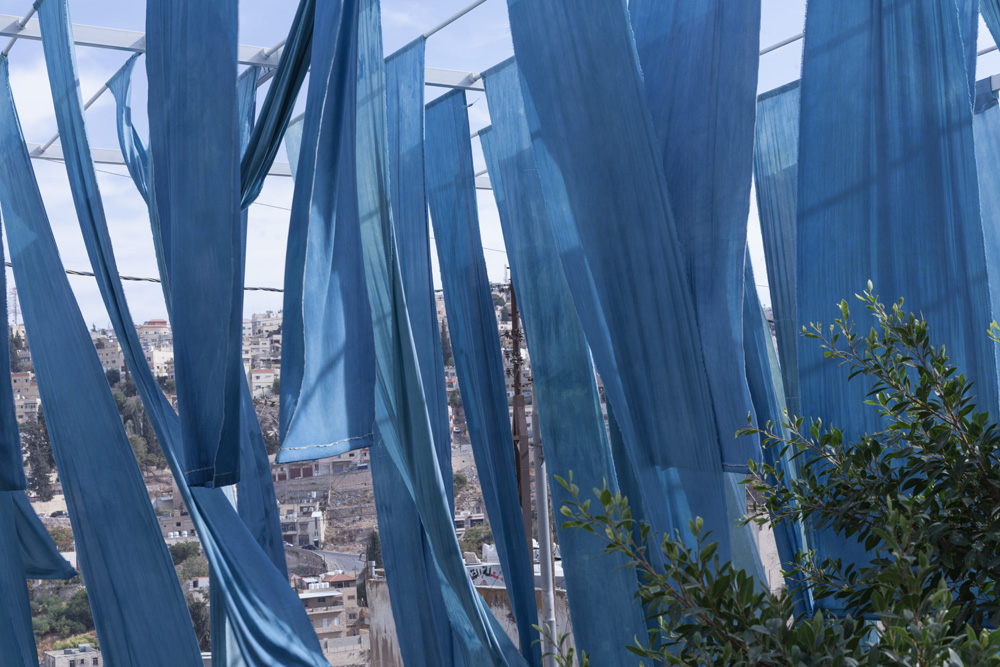

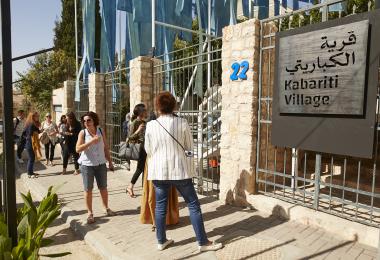
The Crafts District
The Kabariti Village
The Crafts District 2019, curated by Arini, is a pop-up exhibition that took place at the abandoned Kabariti Village, a series of homes and buildings that date back to the 1940s.
© Amman Design Week 2019
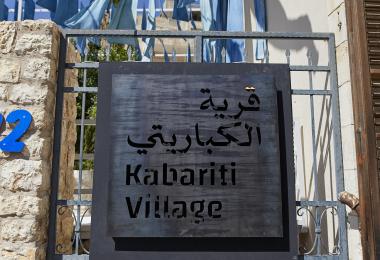
The Crafts District
The Kabariti Village
The Crafts District 2019, curated by Arini, is a pop-up exhibition that took place at the abandoned Kabariti Village, a series of homes and buildings that date back to the 1940s.
© Amman Design Week 2019
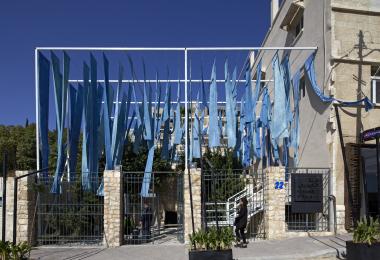
Nīla Canopy, 2019
Arini
At the entrance of the Crafts District 2019 is the Nīla Canopy, designed and conceived by Arini. The fabric was dyed using indigo by the craftswomen of Safi Crafts. The canopy served to highlight the entrance as well as provide shade for the gathering space below.
Photo by Edmund Sumner
© Amman Design Week 2019
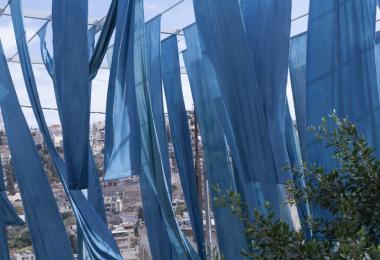
Nīla Canopy, 2019
Arini
At the entrance of the Crafts District 2019 is the Nīla Canopy, designed and conceived by Arini. The fabric was dyed using indigo by the craftswomen of Safi Crafts. The canopy served to highlight the entrance as well as provide shade for the gathering space below.
Photo by Hareth Tabbalat
© Amman Design Week 2019
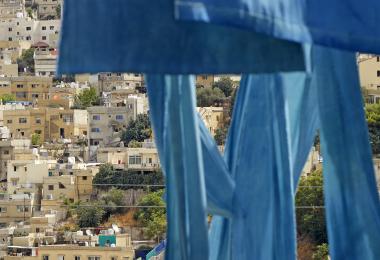
Nīla Canopy, 2019
Arini
At the entrance of the Crafts District 2019 is the Nīla Canopy, designed and conceived by Arini. The fabric was dyed using indigo by the craftswomen of Safi Crafts. The canopy served to highlight the entrance as well as provide shade for the gathering space below.
Photo by Edmund Sumner
© Amman Design Week 2019
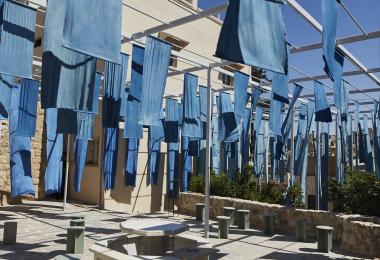
Nīla Canopy, 2019
Arini
At the entrance of the Crafts District 2019 is the Nīla Canopy, designed and conceived by Arini. The fabric was dyed using indigo by the craftswomen of Safi Crafts. The canopy served to highlight the entrance as well as provide shade for the gathering space below.
© Amman Design Week 2019
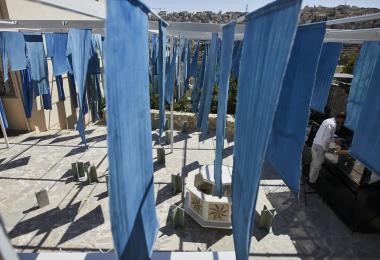
Nīla Canopy, 2019
Arini
At the entrance of the Crafts District 2019 is the Nīla Canopy, designed and conceived by Arini. The fabric was dyed using indigo by the craftswomen of Safi Crafts. The canopy served to highlight the entrance as well as provide shade for the gathering space below.
© Amman Design Week 2019
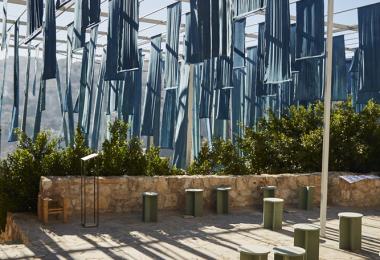
Nīla Canopy, 2019
Arini
At the entrance of the Crafts District 2019 is the Nīla Canopy, designed and conceived by Arini. The fabric was dyed using indigo by the craftswomen of Safi Crafts. The canopy served to highlight the entrance as well as provide shade for the gathering space below.
© Amman Design Week 2019
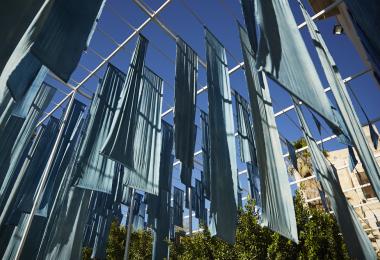
Nīla Canopy, 2019
Arini
At the entrance of the Crafts District 2019 is the Nīla Canopy, designed and conceived by Arini. The fabric was dyed using indigo by the craftswomen of Safi Crafts. The canopy served to highlight the entrance as well as provide shade for the gathering space below.
© Amman Design Week 2019
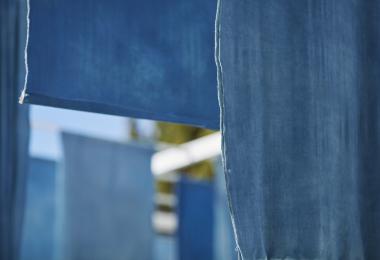
Nīla Canopy, 2019
Arini
At the entrance of the Crafts District 2019 is the Nīla Canopy, designed and conceived by Arini. The fabric was dyed using indigo by the craftswomen of Safi Crafts. The canopy served to highlight the entrance as well as provide shade for the gathering space below.
© Amman Design Week 2019
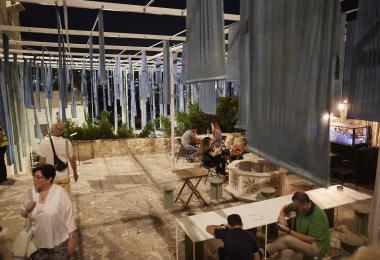
Nīla Canopy, 2019
Arini
At the entrance of the Crafts District 2019 is the Nīla Canopy, designed and conceived by Arini. The fabric was dyed using indigo by the craftswomen of Safi Crafts. The canopy served to highlight the entrance as well as provide shade for the gathering space below.
© Amman Design Week 2019
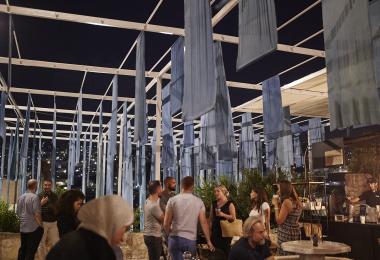
Nīla Canopy, 2019
Arini
At the entrance of the Crafts District 2019 is the Nīla Canopy, designed and conceived by Arini. The fabric was dyed using indigo by the craftswomen of Safi Crafts. The canopy served to highlight the entrance as well as provide shade for the gathering space below.
© Amman Design Week 2019
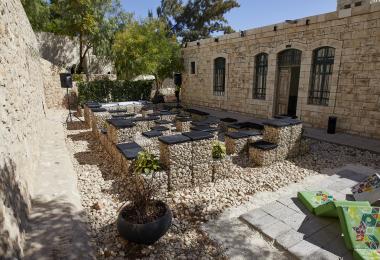
Crafts District Stage, 2019
Arini
© Amman Design Week 2019
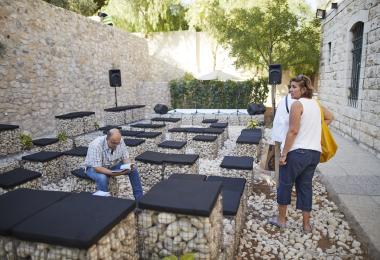
Crafts District Stage, 2019
Arini
© Amman Design Week 2019
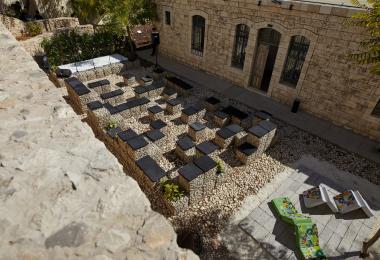
Crafts District Stage, 2019
Arini
© Amman Design Week 2019
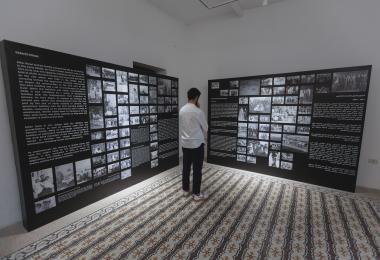
The Crafts District
Kabariti Village History Map
Photo by Hareth Tabbalat
© Amman Design Week 2019
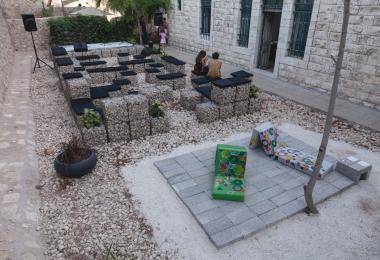
The Crafts District
The Kabariti Village
Photo by Hareth Ramzi
© Amman Design Week 2019
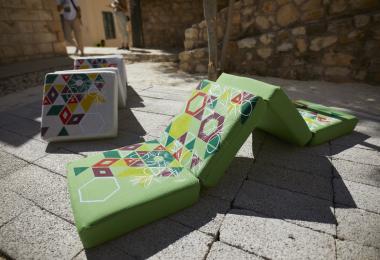
Under the Lemon Tree, 2019
Ghadeer Najjar
'Under the Lemon Tree' consists of four pieces joined together. The work tells the story of a ‘housh’ – the front yards of houses in the Levant (Bilad Al-Sham).
© Amman Design Week 2019
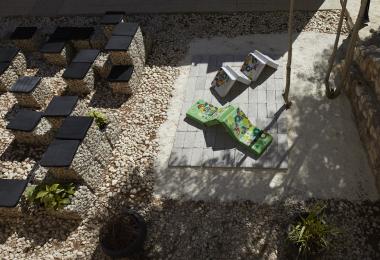
Under the Lemon Tree, 2019
Ghadeer Najjar
'Under the Lemon Tree' consists of four pieces joined together. The work tells the story of a ‘housh’ – the front yards of houses in the Levant (Bilad Al-Sham).
© Amman Design Week 2019
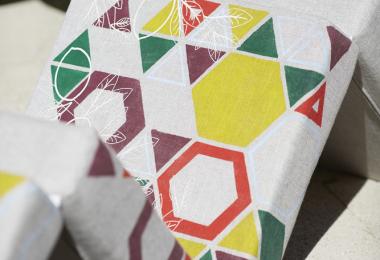
Under the Lemon Tree, 2019
Ghadeer Najjar
'Under the Lemon Tree' consists of four pieces joined together. The work tells the story of a ‘housh’ – the front yards of houses in the Levant (Bilad Al-Sham).
© Amman Design Week 2019
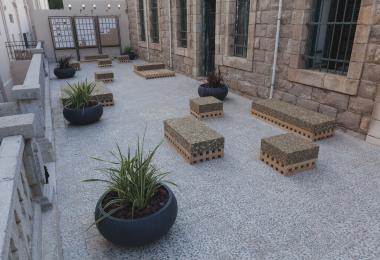
The Crafts District
The Kabariti Village
Photo by Hareth Ramzi
© Amman Design Week 2019
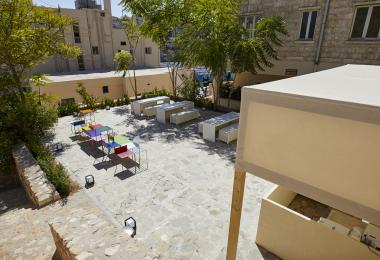
The Crafts District
Food Area
© Amman Design Week 2019
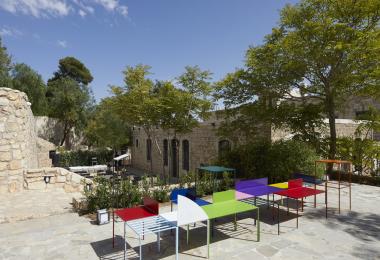
(DIS)CONNECT, 2019
Daniel + Qusai
This modular public interactive installation has different compositions of typical seating elements. The installation was designed to create a setting that will provoke and encourage social interactions. The form follows human ergonomics standards and was modified “to put people on the edge of their seat.”
Photo by Edmund Sumner
© Amman Design Week 2019
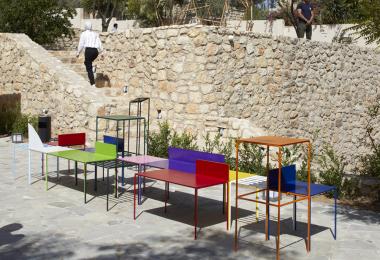
(DIS)CONNECT, 2019
Daniel + Qusai
This modular public interactive installation has different compositions of typical seating elements. The installation was designed to create a setting that will provoke and encourage social interactions. The form follows human ergonomics standards and was modified “to put people on the edge of their seat.”
Photo by Edmund Sumner
© Amman Design Week 2019
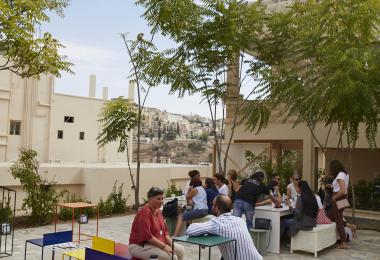
(DIS)CONNECT, 2019
Daniel + Qusai
This modular public interactive installation has different compositions of typical seating elements. The installation was designed to create a setting that will provoke and encourage social interactions. The form follows human ergonomics standards and was modified “to put people on the edge of their seat.”
© Amman Design Week 2019
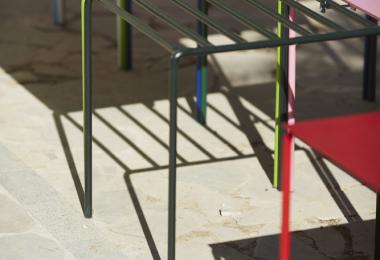
(DIS)CONNECT, 2019
Daniel + Qusai
This modular public interactive installation has different compositions of typical seating elements. The installation was designed to create a setting that will provoke and encourage social interactions. The form follows human ergonomics standards and was modified “to put people on the edge of their seat.”
© Amman Design Week 2019
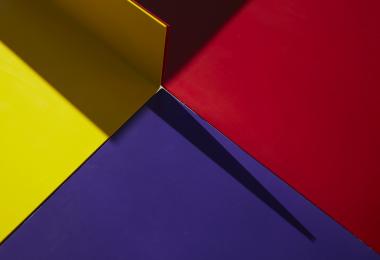
(DIS)CONNECT, 2019
Daniel + Qusai
This modular public interactive installation has different compositions of typical seating elements. The installation was designed to create a setting that will provoke and encourage social interactions. The form follows human ergonomics standards and was modified “to put people on the edge of their seat.”
© Amman Design Week 2019
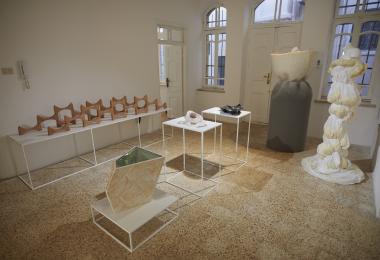
Min Ila'
The Crafts District
Min Ila’ is a showcase curated by Arini that highlights the diversity and importance of material and its manipulation in the realm of crafts and making.
Photo by Edmund Sumner
© Amman Design Week 2019
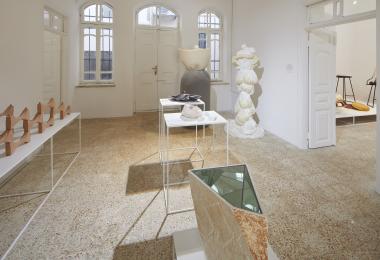
Min Ila'
The Crafts District
Min Ila’ is a showcase curated by Arini that highlights the diversity and importance of material and its manipulation in the realm of crafts and making.
Photo by Edmund Sumner
© Amman Design Week 2019
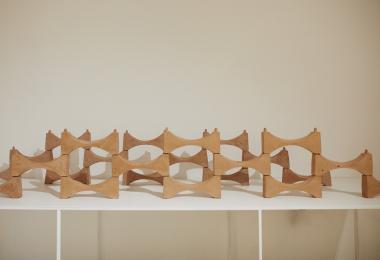
Reshaping the Vessel, 2019
Sama El Saket
‘Reshaping the Vessel’ rethinks the traditional form of the ceramic vessel. The work engages in a dialogue between the handmade, digital, and industrial techniques.
© Amman Design Week 2019
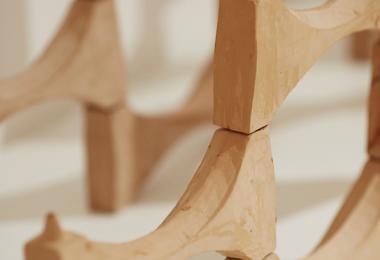
Reshaping the Vessel, 2019
Sama El Saket
‘Reshaping the Vessel’ rethinks the traditional form of the ceramic vessel. The work engages in a dialogue between the handmade, digital, and industrial techniques.
© Amman Design Week 2019
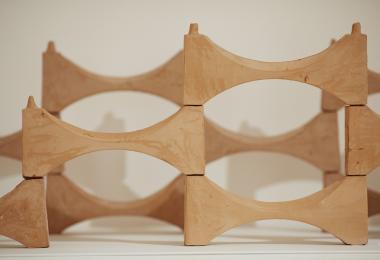
Reshaping the Vessel, 2019
Sama El Saket
‘Reshaping the Vessel’ rethinks the traditional form of the ceramic vessel. The work engages in a dialogue between the handmade, digital, and industrial techniques.
© Amman Design Week 2019
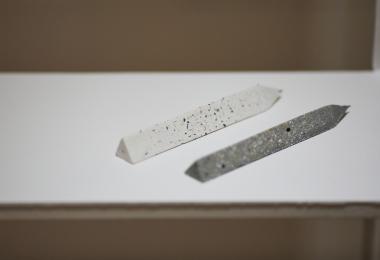
Sakeb, 2019
Raghad Saqfalhait and Mariam Dahabreh
Sakeb is an experimentation with a monolithic pen design that is light and easy to use. The production process started with collecting waste stone chunks from local granite and marble suppliers. Marble pieces are crushed into aggregates and mixed with white cement, sand, and water. The mixture is then poured into a plastic mold and then taken out after 48 hours to be polished.
© Amman Design Week 2019
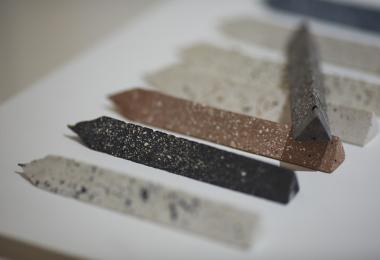
Sakeb, 2019
Raghad Saqfalhait and Mariam Dahabreh
Sakeb is an experimentation with a monolithic pen design that is light and easy to use. The production process started with collecting waste stone chunks from local granite and marble suppliers. Marble pieces are crushed into aggregates and mixed with white cement, sand, and water. The mixture is then poured into a plastic mold and then taken out after 48 hours to be polished.
© Amman Design Week 2019
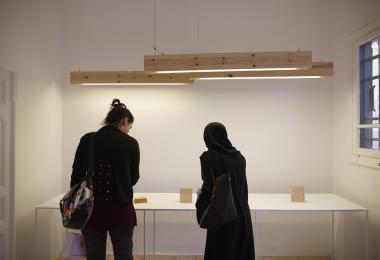
Fish Tail Lamps, 2019
Omar Qubain and Hussein Beydoun
The pendant lamp is composed of three separate lighting units, composed to recall a school of fish.
© Amman Design Week 2019
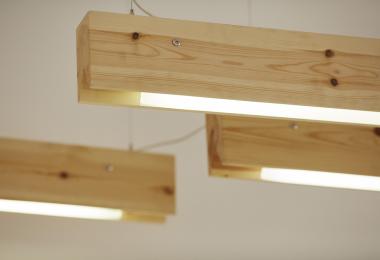
Fish Tail Lamp, 2019
Omar Qubain and Hussein Beydoun
The pendant lamp is composed of three separate lighting units, composed to recall a school of fish.
© Amman Design Week 2019
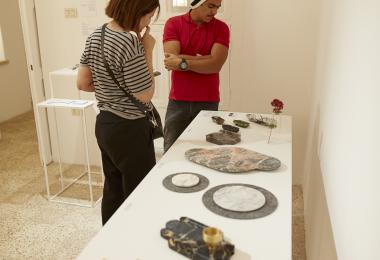
Collection 2019
in doi
in doi’s collection of 2019 is a reflection of patterns that surround us. It reinterprets local techniques to inspire and reinvigorate traditional craft, and uses an extraction of lines, curves, and intersections from our urban landscape.
© Amman Design Week 2019
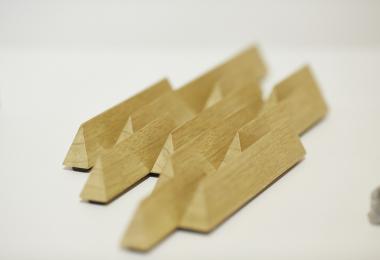
Collection 2019
in doi
in doi’s collection of 2019 is a reflection of patterns that surround us. It reinterprets local techniques to inspire and reinvigorate traditional craft, and uses an extraction of lines, curves, and intersections from our urban landscape.
© Amman Design Week 2019
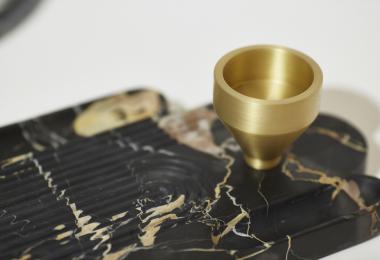
Collection 2019
in doi
in doi’s collection of 2019 is a reflection of patterns that surround us. It reinterprets local techniques to inspire and reinvigorate traditional craft, and uses an extraction of lines, curves, and intersections from our urban landscape.
© Amman Design Week 2019
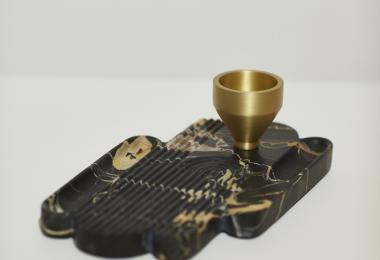
Collection 2019
in doi
in doi’s collection of 2019 is a reflection of patterns that surround us. It reinterprets local techniques to inspire and reinvigorate traditional craft, and uses an extraction of lines, curves, and intersections from our urban landscape.
© Amman Design Week 2019
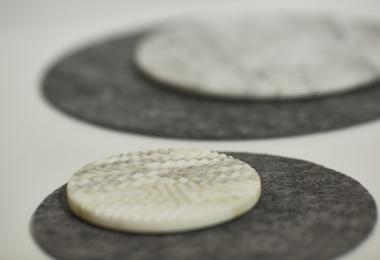
Collection 2019
in doi
in doi’s collection of 2019 is a reflection of patterns that surround us. It reinterprets local techniques to inspire and reinvigorate traditional craft, and uses an extraction of lines, curves, and intersections from our urban landscape.
© Amman Design Week 2019
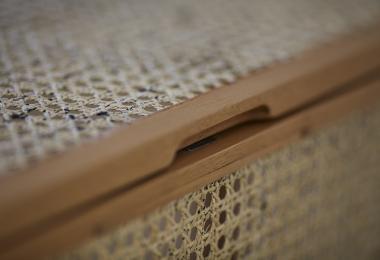
Nostalgia, 2019
Kaarim Design District
The design uses the different patterns created by the traditional technique of rattan weaving. This sustainable, natural, and handcrafted material is applied on multi-functional, stackable blocks.
© Amman Design Week 2019
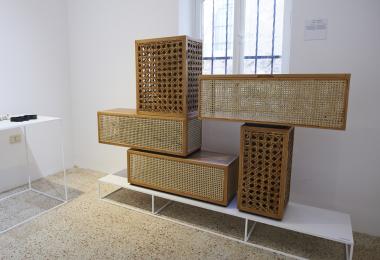
Nostalgia, 2019
Kaarim Design District
The design uses the different patterns created by the traditional technique of rattan weaving. This sustainable, natural, and handcrafted material is applied on multi-functional, stackable blocks.
© Amman Design Week 2019
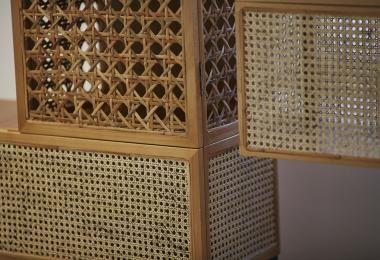
Nostalgia, 2019
Kaarim Design District
The design uses the different patterns created by the traditional technique of rattan weaving. This sustainable, natural, and handcrafted material is applied on multi-functional, stackable blocks.
© Amman Design Week 2019
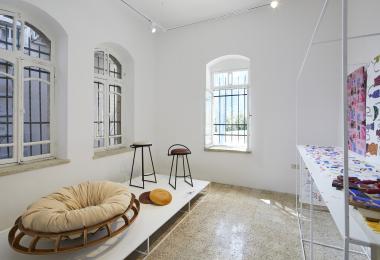
Min Ila
The Crafts District
Min Ila’ is a showcase curated by Arini that highlights the diversity and importance of material and its manipulation in the realm of crafts and making.
Photo by Edmund Sumner
© Amman Design Week 2019
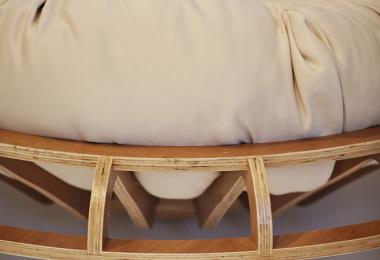
aleia, 2018
najla'a
aleia introduces an experimentation in posture, user interaction, and form.
© Amman Design Week 2019
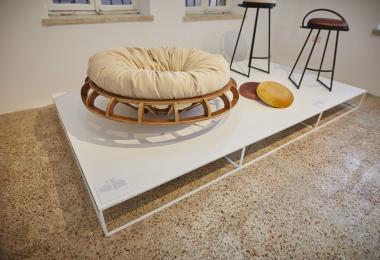
aleia, 2018 and nisf, 2019
najla'a
aleia introduces an experimentation in posture, user interaction, and form.
‘nisf’ is a minimalist stool with an adjustable back support that doubles as a handle. Its raw, neutral, metal frame works in a variety of settings ranging from home kitchens to restaurant bars.
© Amman Design Week 2019
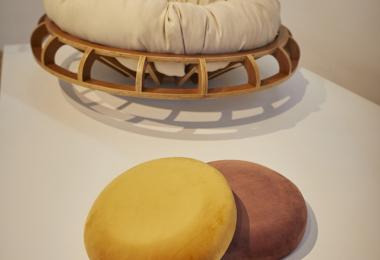
aleia, 2018 and nisf, 2019
najla'a
aleia introduces an experimentation in posture, user interaction, and form.
‘nisf’ is a minimalist stool with an adjustable back support that doubles as a handle. Its raw, neutral, metal frame works in a variety of settings ranging from home kitchens to restaurant bars.
© Amman Design Week 2019
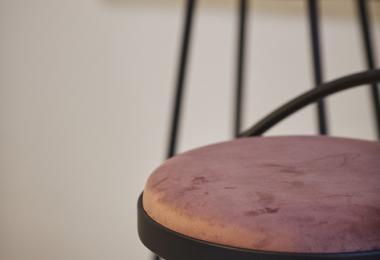
nisf, 2019
najla'a
‘nisf’ is a minimalist stool with an adjustable back support that doubles as a handle. Its raw, neutral, metal frame works in a variety of settings ranging from home kitchens to restaurant bars.
© Amman Design Week 2019
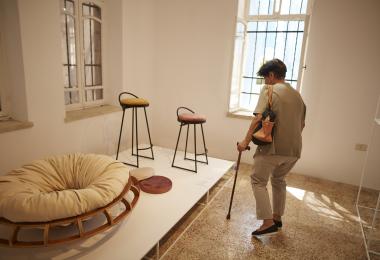
aleia, 2018 and nisf, 2019
najla'a
aleia introduces an experimentation in posture, user interaction, and form.
‘nisf’ is a minimalist stool with an adjustable back support that doubles as a handle. Its raw, neutral, metal frame works in a variety of settings ranging from home kitchens to restaurant bars.
© Amman Design Week 2019
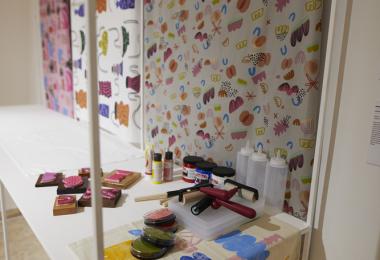
Pattern Play with Lena Kassicieh, 2019
Lena Kassicieh
Lena Kassicieh developed a line of textile patterns that are cheerful and bright using block printing and pattern stamping in this interactive installation.
© Amman Design Week 2019
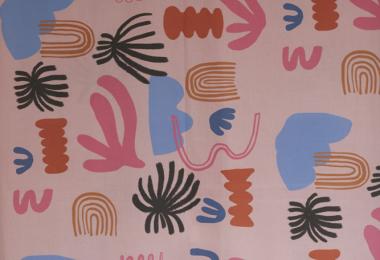
Pattern Play with Lena Kassicieh, 2019
Lena Kassicieh
Lena Kassicieh developed a line of textile patterns that are cheerful and bright using block printing and pattern stamping in this interactive installation.
© Amman Design Week 2019
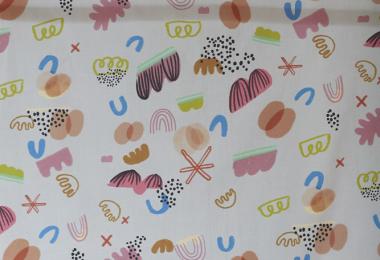
Pattern Play with Lena Kassicieh, 2019
Lena Kassicieh
Lena Kassicieh developed a line of textile patterns that are cheerful and bright using block printing and pattern stamping in this interactive installation.
© Amman Design Week 2019
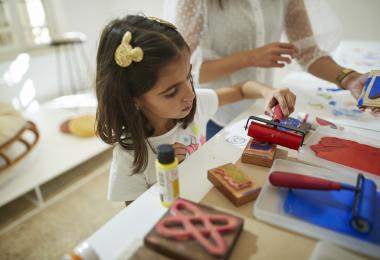
Pattern Play with Lena Kassicieh, 2019
Lena Kassicieh
Lena Kassicieh developed a line of textile patterns that are cheerful and bright using block printing and pattern stamping in this interactive installation.
© Amman Design Week 2019
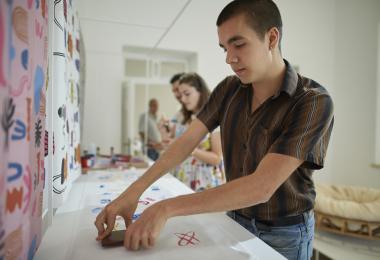
Pattern Play with Lena Kassicieh, 2019
Lena Kassicieh
Lena Kassicieh developed a line of textile patterns that are cheerful and bright using block printing and pattern stamping in this interactive installation.
© Amman Design Week 2019
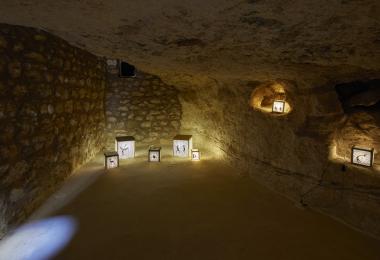
LUCEM Lights | The Shadow Cave
Paradigm DH
Set in a cave in the Kabariti Village, and displayed as a form of shadow theatre, this installation is composed of LUCEM lights, a collection of lighting fixtures made from translucent concrete; a composite of concrete embedded with fiber optics that transmit light.
Photo by Edmund Sumner
© Amman Design Week 2019
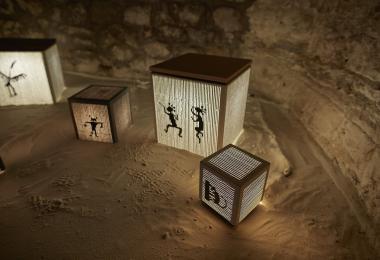
LUCEM Lights | The Shadow Cave
Paradigm DH
Set in a cave in the Kabariti Village, and displayed as a form of shadow theatre, this installation is composed of LUCEM lights, a collection of lighting fixtures made from translucent concrete; a composite of concrete embedded with fiber optics that transmit light.
© Amman Design Week 2019
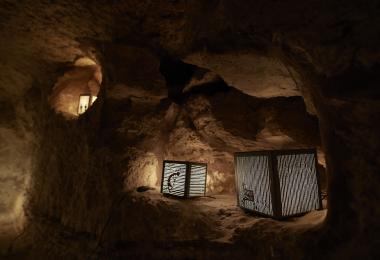
LUCEM Lights | The Shadow Cave
Paradigm DH
Set in a cave in the Kabariti Village, and displayed as a form of shadow theatre, this installation is composed of LUCEM lights, a collection of lighting fixtures made from translucent concrete; a composite of concrete embedded with fiber optics that transmit light.
© Amman Design Week 2019
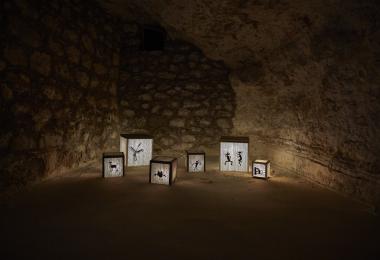
LUCEM Lights | The Shadow Cave
Paradigm DH
Set in a cave in the Kabariti Village, and displayed as a form of shadow theatre, this installation is composed of LUCEM lights, a collection of lighting fixtures made from translucent concrete; a composite of concrete embedded with fiber optics that transmit light.
© Amman Design Week 2019
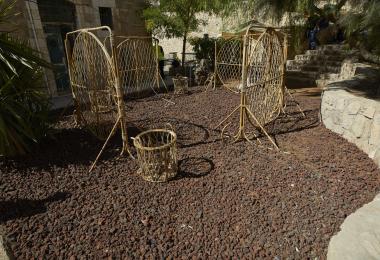
Stitches in Space, 2019
Ruba Asi
Stitches in Space is a blown-up play experience for children inspired by the fiber arts that also highlights Amman's 60 year old rattan furniture craft. The installation, which is comprised of four stitching screens and equipped with jute ropes and giant wooden needles is a polemic against the “watching” culture brought about by the pervasiveness of digital screens in the psyche of the modern child. This trend could single handedly be identified as a prime cause for the present day decline of genuine play and the distortion thereof of play as an existential human need.
The design aims to restore the centrality of the entire human body in the act of play. Where digital screens reduce the experience of gameplay to visual or purely abstract aspects, they are replaced here with large-scale screens for stitching rope.
© Amman Design Week 2019
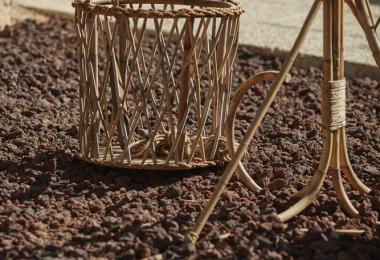
Stitches in Space, 2019
Ruba Asi
Stitches in Space is a blown-up play experience for children inspired by the fiber arts that also highlights Amman's 60 year old rattan furniture craft. The installation, which is comprised of four stitching screens and equipped with jute ropes and giant wooden needles is a polemic against the “watching” culture brought about by the pervasiveness of digital screens in the psyche of the modern child. This trend could single handedly be identified as a prime cause for the present day decline of genuine play and the distortion thereof of play as an existential human need.
The design aims to restore the centrality of the entire human body in the act of play. Where digital screens reduce the experience of gameplay to visual or purely abstract aspects, they are replaced here with large-scale screens for stitching rope.
© Amman Design Week 2019
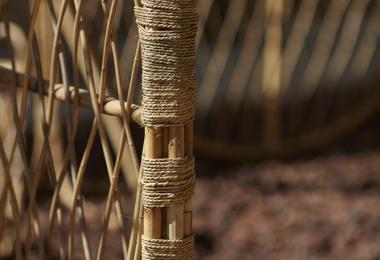
Stitches in Space, 2019
Ruba Asi
Stitches in Space is a blown-up play experience for children inspired by the fiber arts that also highlights Amman's 60 year old rattan furniture craft. The installation, which is comprised of four stitching screens and equipped with jute ropes and giant wooden needles is a polemic against the “watching” culture brought about by the pervasiveness of digital screens in the psyche of the modern child. This trend could single handedly be identified as a prime cause for the present day decline of genuine play and the distortion thereof of play as an existential human need.
The design aims to restore the centrality of the entire human body in the act of play. Where digital screens reduce the experience of gameplay to visual or purely abstract aspects, they are replaced here with large-scale screens for stitching rope.
© Amman Design Week 2019
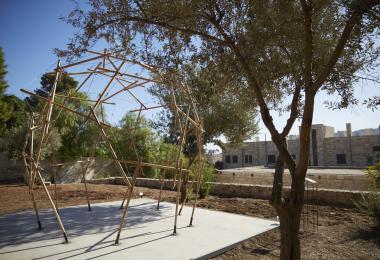
Reciprocal Frame Tensegrity Pavilion, 2019
Yazeed Balqar
A reciprocal frame is a self-supporting structure made of three or more beams arranged in a closed circuit. This pavilion takes reciprocal frames a step further by adding tensegrity to the structure, which is a combination of strut weight and cable tension. The pavilion’s struts are designed to be reusable and can be disassembled to create other geometries and shapes. This structure is an exploration of a four-frequency Buckminster Fuller dome.
© Amman Design Week 2019
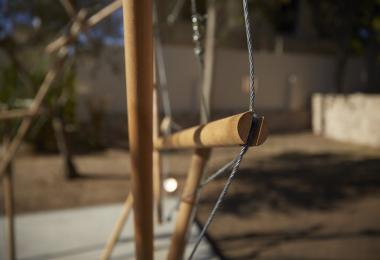
Reciprocal Frame Tensegrity Pavilion, 2019
Yazeed Balqar
A reciprocal frame is a self-supporting structure made of three or more beams arranged in a closed circuit. This pavilion takes reciprocal frames a step further by adding tensegrity to the structure, which is a combination of strut weight and cable tension. The pavilion’s struts are designed to be reusable and can be disassembled to create other geometries and shapes. This structure is an exploration of a four-frequency Buckminster Fuller dome.
© Amman Design Week 2019
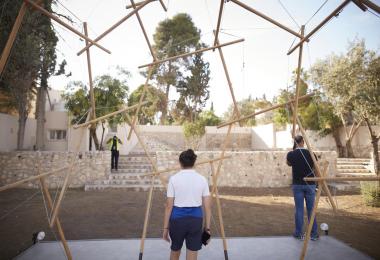
Reciprocal Frame Tensegrity Pavilion, 2019
Yazeed Balqar
A reciprocal frame is a self-supporting structure made of three or more beams arranged in a closed circuit. This pavilion takes reciprocal frames a step further by adding tensegrity to the structure, which is a combination of strut weight and cable tension. The pavilion’s struts are designed to be reusable and can be disassembled to create other geometries and shapes. This structure is an exploration of a four-frequency Buckminster Fuller dome.
© Amman Design Week 2019
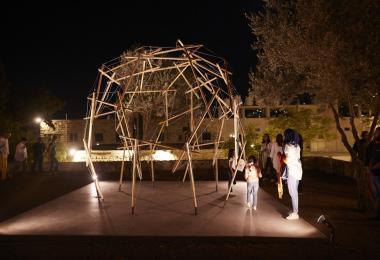
Reciprocal Frame Tensegrity Pavilion
Yazeed Balqar
A reciprocal frame is a self-supporting structure made of three or more beams arranged in a closed circuit. This pavilion takes reciprocal frames a step further by adding tensegrity to the structure, which is a combination of strut weight and cable tension. The pavilion’s struts are designed to be reusable and can be disassembled to create other geometries and shapes. This structure is an exploration of a four-frequency Buckminster Fuller dome.
© Amman Design Week 2019
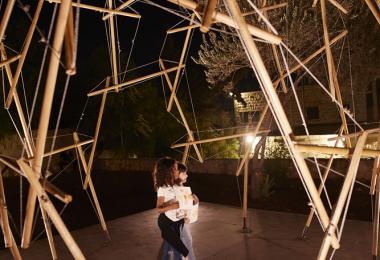
Reciprocal Frame Tensegrity Pavilion, 2019
Yazeed Balqar
A reciprocal frame is a self-supporting structure made of three or more beams arranged in a closed circuit. This pavilion takes reciprocal frames a step further by adding tensegrity to the structure, which is a combination of strut weight and cable tension. The pavilion’s struts are designed to be reusable and can be disassembled to create other geometries and shapes. This structure is an exploration of a four-frequency Buckminster Fuller dome.
© Amman Design Week 2019
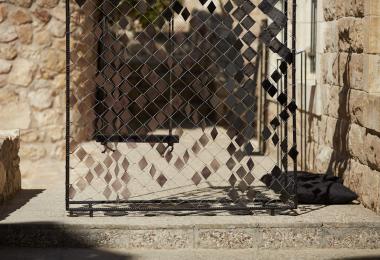
Besat, 2019
Tasmeem l ll amani tabaza
An interactive urban module inspired by woven Bedouin rug patterns in Jordan.
A ‘besat’ is a module for rest and entertainment in traditional gatherings. The urban module values the instinctive and skillful hand of a Bedouin woman, weaving unplanned patterns, which are used in contemporary times as modern art.
The module is made of waste construction materials to work as a sustainable contribution to society as well.
© Amman Design Week 2019
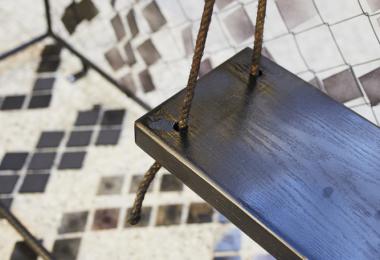
Besat, 2019
Tasmeem l ll amani tabaza
An interactive urban module inspired by woven Bedouin rug patterns in Jordan.
A ‘besat’ is a module for rest and entertainment in traditional gatherings. The urban module values the instinctive and skillful hand of a Bedouin woman, weaving unplanned patterns, which are used in contemporary times as modern art.
The module is made of waste construction materials to work as a sustainable contribution to society as well.
© Amman Design Week 2019
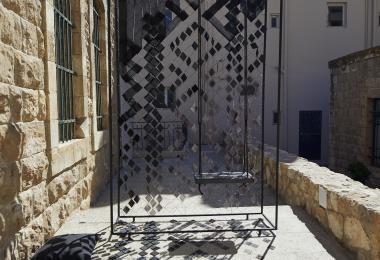
Besat, 2019
Tasmeem l ll amani tabaza
An interactive urban module inspired by woven Bedouin rug patterns in Jordan.
A ‘besat’ is a module for rest and entertainment in traditional gatherings. The urban module values the instinctive and skillful hand of a Bedouin woman, weaving unplanned patterns, which are used in contemporary times as modern art.
The module is made of waste construction materials to work as a sustainable contribution to society as well.
© Amman Design Week 2019
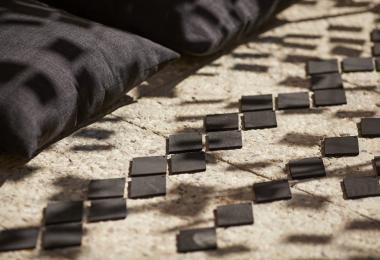
Besat, 2019
Tasmeem l ll amani tabaza
An interactive urban module inspired by woven Bedouin rug patterns in Jordan.
A ‘besat’ is a module for rest and entertainment in traditional gatherings. The urban module values the instinctive and skillful hand of a Bedouin woman, weaving unplanned patterns, which are used in contemporary times as modern art.
The module is made of waste construction materials to work as a sustainable contribution to society as well.
© Amman Design Week 2019
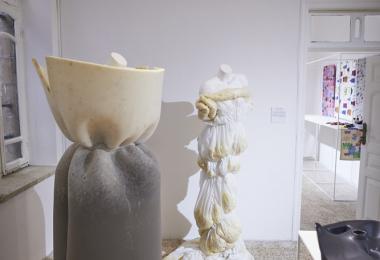
Mojahara, 2019
Fadi Zumot
These works are made of deconstructed mattress materials. The aim of the used materials is to create an inclusive fashion collection. The collection tackles intimacy and personal space.
© Amman Design Week 2019
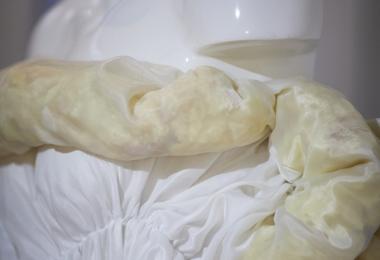
Mojahara, 2019
Fadi Zumot
These works are made of deconstructed mattress materials. The aim of the used materials is to create an inclusive fashion collection. The collection tackles intimacy and personal space.
© Amman Design Week 2019
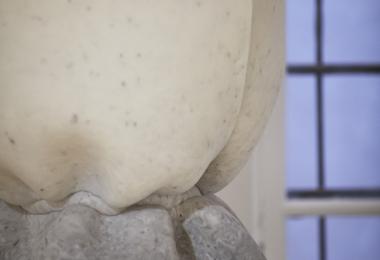
Mojahara, 2019
Fadi Zumot
These works are made of deconstructed mattress materials. The aim of the used materials is to create an inclusive fashion collection. The collection tackles intimacy and personal space.
© Amman Design Week 2019
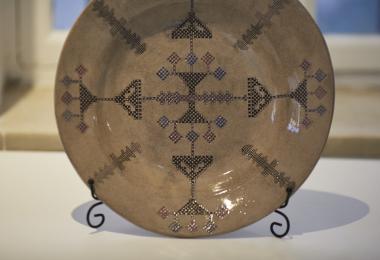
Turabi, 2019
Inas Halabi
Turabi is inspired by traditional pottery where beauty radiates through natural colours with minimalist yet functional designs. This is combined with a love for ‘tatreez’, where embroidery patterns (each with its own story to tell) are carefully hand-carved into the clay. The designer uses different traditional clay making techniques in glazing and marbling in addition to recycling unfired clay to create new pieces that are 100% food safe and lead free.
© Amman Design Week 2019
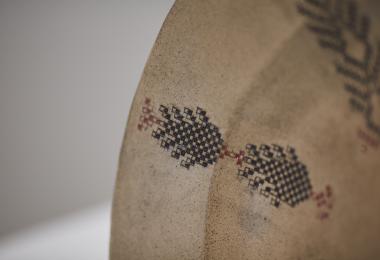
Turabi, 2019
Inas Halabi
Turabi is inspired by traditional pottery where beauty radiates through natural colours with minimalist yet functional designs. This is combined with a love for ‘tatreez’, where embroidery patterns (each with its own story to tell) are carefully hand-carved into the clay. The designer uses different traditional clay making techniques in glazing and marbling in addition to recycling unfired clay to create new pieces that are 100% food safe and lead free.
© Amman Design Week 2019
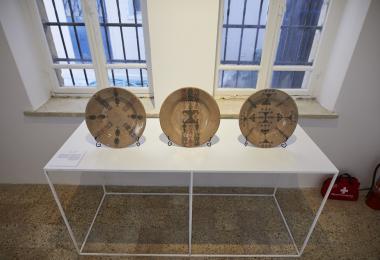
Turabi, 2019
Inas Halabi
Turabi is inspired by traditional pottery where beauty radiates through natural colours with minimalist yet functional designs. This is combined with a love for ‘tatreez’, where embroidery patterns (each with its own story to tell) are carefully hand-carved into the clay. The designer uses different traditional clay making techniques in glazing and marbling in addition to recycling unfired clay to create new pieces that are 100% food safe and lead free.
© Amman Design Week 2019
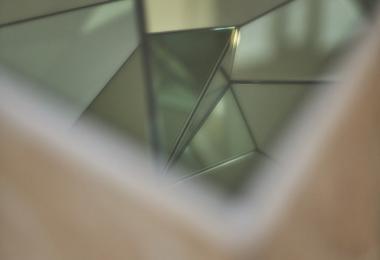
Stereomono, 2019
Andre Mcheileh
‘Stereomono’ uses the nature and specifications of materials as a tool to express a thought or a feeling in contrast to the aesthetic qualities they hold.
© Amman Design Week 2019
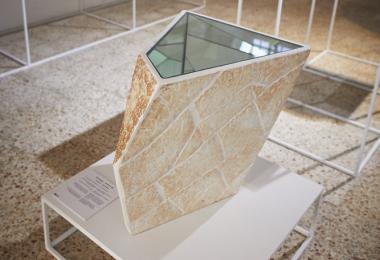
Stereomono, 2019
Andre Mcheileh
‘Stereomono’ uses the nature and specifications of materials as a tool to express a thought or a feeling in contrast to the aesthetic qualities they hold.
© Amman Design Week 2019
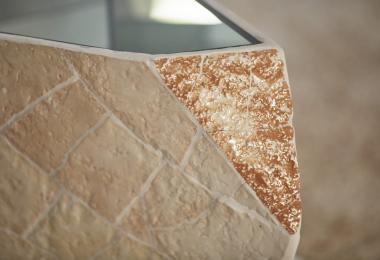
Stereomono, 2019
Andre Mcheileh
‘Stereomono’ uses the nature and specifications of materials as a tool to express a thought or a feeling in contrast to the aesthetic qualities they hold.
© Amman Design Week 2019
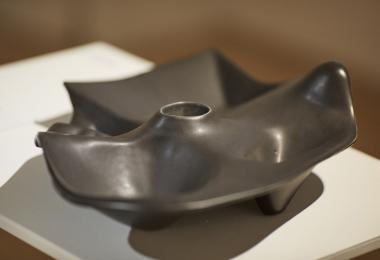
Diskur, 2019
Paola Farran
Diskur is a redesign of the traditional Jordanian meal dish.
© Amman Design Week 2019
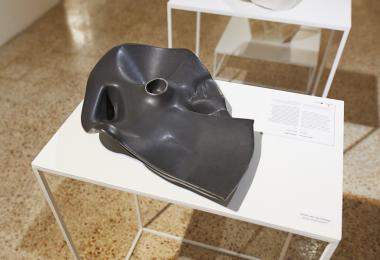
Diskur, 2019
Paola Farran
Diskur is a redesign of the traditional Jordanian meal dish.
© Amman Design Week 2019
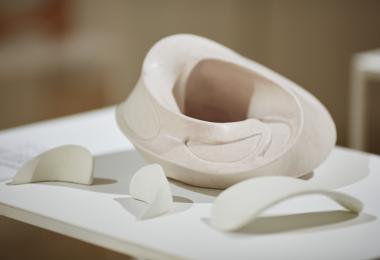
rawe’e, 2019
Safieh Hatough
The project consists of three sensory objects used for soothing different parts of the body through the sense of temperature.
© Amman Design Week 2019
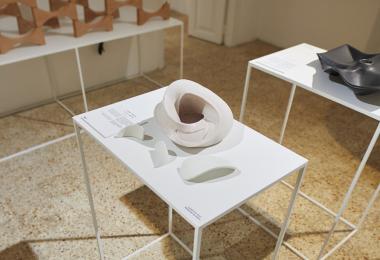
rawe’e, 2019
Safieh Hatough
The project consists of three sensory objects used for soothing different parts of the body through the sense of temperature.
© Amman Design Week 2019
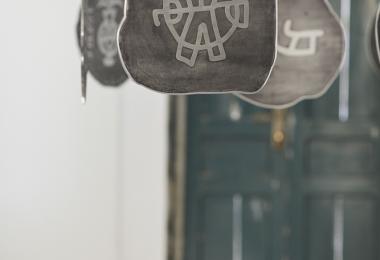
Of Letters & Coins A Coins Installation, 2019
Hussein Alazaat
In this installation, Hussein Alazaat takes us on a journey into Jordan’s history, depicting the various scripts of Jordan on oversized coins (real and imaginary).
Jordan is one of the world’s oldest crossroads, harboring powerful kingdoms and trading centers, as attested to by the diversity of scripts on coins and inscriptions found within its present borders. The writings attest to the trading routes of Jordan’s past and present civilizations. The scripts range from petroglyphs, to Safaitic, Aramaic, Nabataean, Greek, Latin, and Arabic. They display a wealth of lettering styles from iconic sites and significant periods.
This work was exhibited as part of Jordan Script Routes, curated by Huda Abi-Fares.
© Amman Design Week 2019
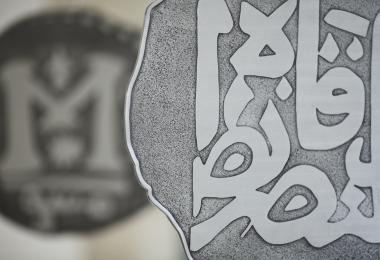
Of Letters & Coins A Coins Installation, 2019
Hussein Alazaat
In this installation, Hussein Alazaat takes us on a journey into Jordan’s history, depicting the various scripts of Jordan on oversized coins (real and imaginary).
Jordan is one of the world’s oldest crossroads, harboring powerful kingdoms and trading centers, as attested to by the diversity of scripts on coins and inscriptions found within its present borders. The writings attest to the trading routes of Jordan’s past and present civilizations. The scripts range from petroglyphs, to Safaitic, Aramaic, Nabataean, Greek, Latin, and Arabic. They display a wealth of lettering styles from iconic sites and significant periods.
This work was exhibited as part of Jordan Script Routes, curated by Huda Abi-Fares.
© Amman Design Week 2019
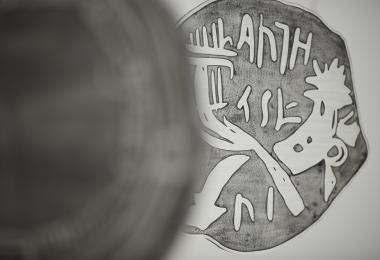
Of Letters & Coins A Coins Installation, 2019
Hussein Alazaat
In this installation, Hussein Alazaat takes us on a journey into Jordan’s history, depicting the various scripts of Jordan on oversized coins (real and imaginary).
Jordan is one of the world’s oldest crossroads, harboring powerful kingdoms and trading centers, as attested to by the diversity of scripts on coins and inscriptions found within its present borders. The writings attest to the trading routes of Jordan’s past and present civilizations. The scripts range from petroglyphs, to Safaitic, Aramaic, Nabataean, Greek, Latin, and Arabic. They display a wealth of lettering styles from iconic sites and significant periods.
This work was exhibited as part of Jordan Script Routes, curated by Huda Abi-Fares.
© Amman Design Week 2019
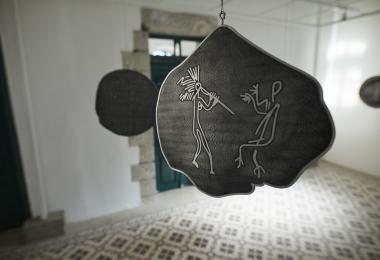
Of Letters & Coins A Coins Installation, 2019
Hussein Alazaat
In this installation, Hussein Alazaat takes us on a journey into Jordan’s history, depicting the various scripts of Jordan on oversized coins (real and imaginary).
Jordan is one of the world’s oldest crossroads, harboring powerful kingdoms and trading centers, as attested to by the diversity of scripts on coins and inscriptions found within its present borders. The writings attest to the trading routes of Jordan’s past and present civilizations. The scripts range from petroglyphs, to Safaitic, Aramaic, Nabataean, Greek, Latin, and Arabic. They display a wealth of lettering styles from iconic sites and significant periods.
This work was exhibited as part of Jordan Script Routes, curated by Huda Abi-Fares.
© Amman Design Week 2019
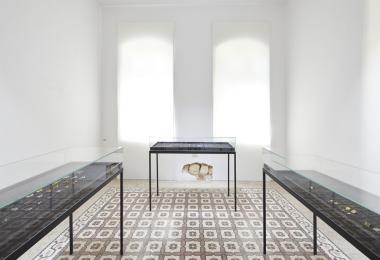
Jordan Script Routes
Jewelry display by Margherita Abi Hanna
This work was exhibited as part of Jordan Script Routes, curated by Huda Abi-Fares.
Photo by Edmund Sumner
© Amman Design Week 2019
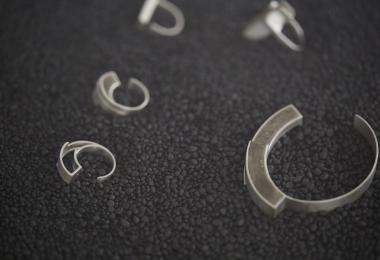
My Concrete City, 2016
Margherita Abi Hanna
The silver and concrete jewelry collection honors and preserves elements of Beirut’s built heritage by adapting signature design features into iconic pieces for both men and women.
This work was exhibited as part of Jordan Script Routes, curated by Huda Abi-Fares.
© Amman Design Week 2019
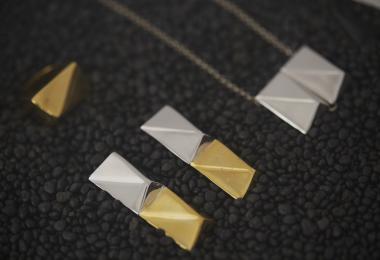
Tiled, 2018
Margherita Abi Hanna
A series of four singular tiles become the silver, gold-plated silver, and enameled modular jewelry pieces that can be worn individually or in tiled combinations.
This work was exhibited as part of Jordan Script Routes, curated by Huda Abi-Fares.
© Amman Design Week 2019
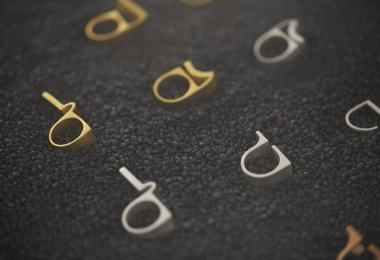
Distorted, 2012
Margherita Abi Hanna
During the production process, the manufacturer of this piece was having trouble extracting the mould for one of the rings, the metal kept twisting and warping as it was hardening.
This work was exhibited as part of Jordan Script Routes, curated by Huda Abi-Fares.
© Amman Design Week 2019
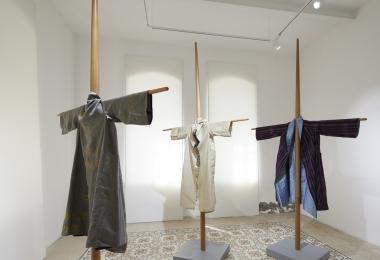
Kimabayas
Milia Maroun
This work was exhibited as part of Jordan Script Routes, curated by Huda Abi-Fares.
Photo by Edmund Sumner
© Amman Design Week 2019
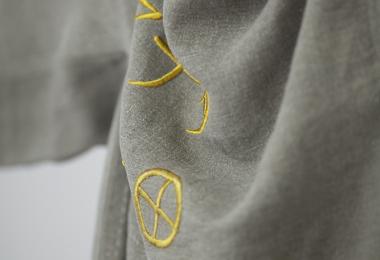
Silk Rogue, 2019
Milia Maroun
Created for the Nomadic Traces, Journeys of Arabian Scripts exhibition at Warehouse 421 in Abu Dhabi. The Silk Rogue Kimabaya builds upon the themes of fluidity and exchange. Two ancient scripts, Phoenician and Japanese Katakana characters are brought together on this canvas-like Kimabaya, highlighting their intriguing similarities. The scripts are embroidered in gold thread, a color and material of great historical importance in Middle and Far Eastern societies. This use of thread suggests links to both the golden age and the silk road era which are being invoked in this design.
This work was exhibited as part of Jordan Script Routes, curated by Huda Abi-Fares.
© Amman Design Week 2019
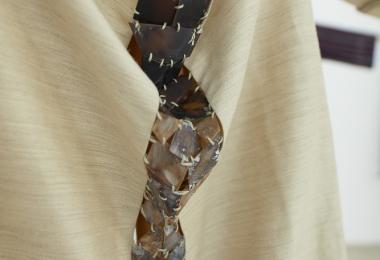
Mother of Pearl, 2016
Milia Maroun
This Kimabaya is a fusion of Far Eastern (Japanese) influences and Middle Eastern craft. The piece was made in collaboration with Nada Debs, a Lebanese designer who grew up in Japan, reaching a perfect synthesis of minimalism and oriental expansion. The resulting Kimabaya is a stunning blend of influences and styles in which parts of the skeleton, often used in Japan as the basis for clothing design, are picked out in delicate mother of pearl, imitating the spine.
This work was exhibited as part of Jordan Script Routes, curated by Huda Abi-Fares.
© Amman Design Week 2019
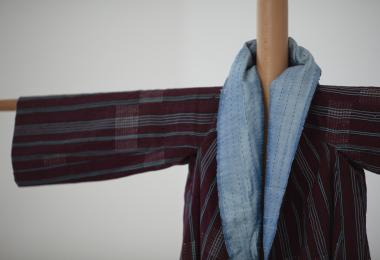
Nigerian Purple, 2017
Milia Maroun
Created for the Kimabaya exhibition at Espace Muraille Gallery in Geneva. This prestigious 19th century Asoke cloth is originally a women’s wrapper. The Yoruba in Nigeria reserved this cloth for funerals, religious rituals, and other formal occasions. It is handwoven in 4-inch wide strips that vary in length. This antique Asoke cloth is characterized by its openwork or holes. It is known for supplementary inlays, which are generally made of threads on a background of silk cotton. This elaborate Nigerian Purple Kimabaya took more than 60 hours to create.
This work was exhibited as part of Jordan Script Routes, curated by Huda Abi-Fares.
© Amman Design Week 2019
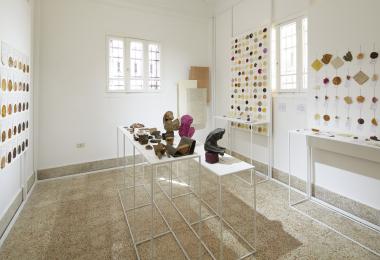
Material Innovation
Material Innovation is an exhibition showcasing the results of a research workshop entitled ‘Textile Innovation Lab I - Material Innovation’ that took place in December 2018, organized by Amman Design Week and the Goethe Institute in Amman, and under the facilitation and mentorship of German textile designer Annette Fauvel.
The Material Innovation exhibition introduces new processes in which sustainable and alternative materials can be produced and used in textile applications. It showcases works by designers who have experimented with merging the traditional techniques of natural dyeing, paper-making, embroidery, and weaving, with new experimental methods and materials such as bioplastics and kombucha leather growing.
Photo by Edmund Sumner
© Amman Design Week 2019
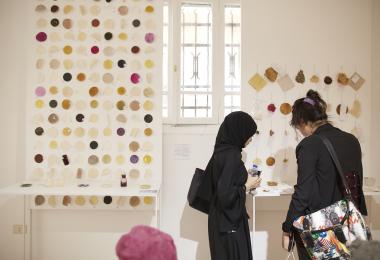
Material Innovation
Material Innovation is an exhibition showcasing the results of a research workshop entitled ‘Textile Innovation Lab I - Material Innovation’ that took place in December 2018, organized by Amman Design Week and the Goethe Institute in Amman, and under the facilitation and mentorship of German textile designer Annette Fauvel.
The Material Innovation exhibition introduces new processes in which sustainable and alternative materials can be produced and used in textile applications. It showcases works by designers who have experimented with merging the traditional techniques of natural dyeing, paper-making, embroidery, and weaving, with new experimental methods and materials such as bioplastics and kombucha leather growing.
Photo by Edmund Sumner
© Amman Design Week 2019
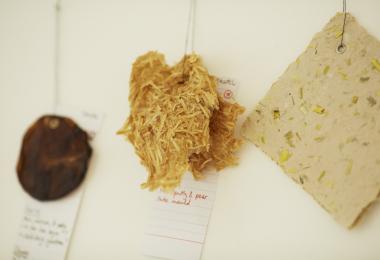
Demonstration, 2018
Annette Fauvel
Samples of materials created using three different methods; kombucha-growing, paper-making, and bioplastic-cooking. The samples showcase the variety of possible results, properties, and hence speculative applications.
These methods contribute to a more sustainable, material future, as they are made out of 100% natural, non-toxic raw materials. Besides, most of the materials are found or processed in Jordan or can be replaced by local raw materials.
© Amman Design Week 2019
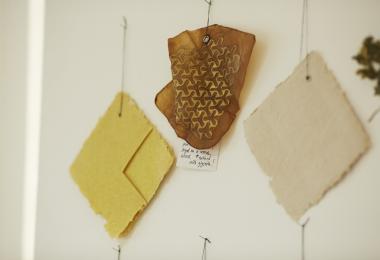
Demonstration, 2018
Annette Fauvel
Samples of materials created using three different methods; kombucha-growing, paper-making, and bioplastic-cooking. The samples showcase the variety of possible results, properties, and hence speculative applications.
These methods contribute to a more sustainable, material future, as they are made out of 100% natural, non-toxic raw materials. Besides, most of the materials are found or processed in Jordan or can be replaced by local raw materials.
© Amman Design Week 2019
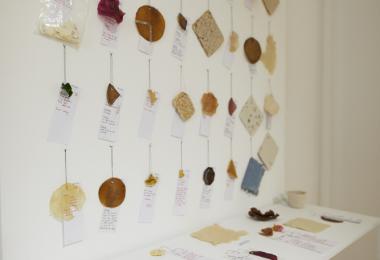
Demonstration, 2018
Annette Fauvel
Samples of materials created using three different methods; kombucha-growing, paper-making, and bioplastic-cooking. The samples showcase the variety of possible results, properties, and hence speculative applications.
These methods contribute to a more sustainable, material future, as they are made out of 100% natural, non-toxic raw materials. Besides, most of the materials are found or processed in Jordan or can be replaced by local raw materials.
© Amman Design Week 2019
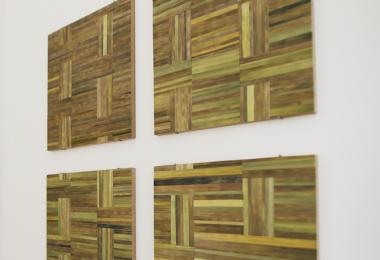
Material Waste, 2019
Christin Mannewitz
Wall and acoustic panels made out of plant-based waste material.
© Amman Design Week 2019
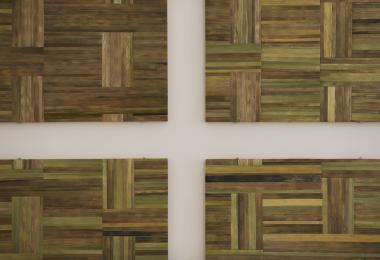
Material Waste, 2019
Christin Mannewitz
Wall and acoustic panels made out of plant-based waste material.
© Amman Design Week 2019
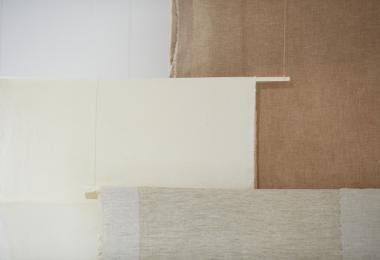
Natural Waterproof Textiles, 2019
Lisa Schreiber
These textile samples are the result of experiments with natural textiles and gelatin-based bioplastics as a covering. The aim of the experiments was to develop a waterproof textile without environmentally harmful chemicals. The resulting samples vary in their quality characteristics such as resistance to water and flexibility, depending on the used materials and combinations.
To improve the impermeability of the bioplastics, natural waxes, oils and resins were added. The colors are the result of the combination of the original fabric color with naturally dyed bioplastics.
© Amman Design Week 2019
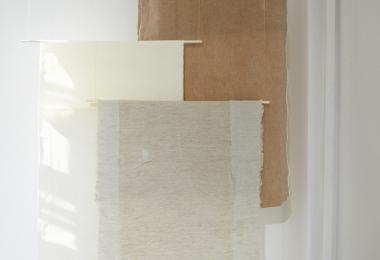
Natural Waterproof Textiles, 2019
Lisa Schreiber
These textile samples are the result of experiments with natural textiles and gelatin-based bioplastics as a covering. The aim of the experiments was to develop a waterproof textile without environmentally harmful chemicals. The resulting samples vary in their quality characteristics such as resistance to water and flexibility, depending on the used materials and combinations.
To improve the impermeability of the bioplastics, natural waxes, oils and resins were added. The colors are the result of the combination of the original fabric color with naturally dyed bioplastics.
© Amman Design Week 2019
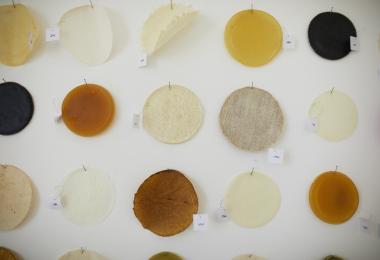
Scoby Science, 2018 - 2019
Katja Lonzec
In an attempt to search for organic alternatives and the need to rethink our relationship with material consumption, this work explores a material that lasts within a single product life cycle; a material that is durable and self expiring; a material that is able to recreate itself nearly endlessly and doesn‘t require any finite resources.
By exploring the possibility of cultivated fungal and bacterial matter, a biological and sustainable material was developed that could be used to replace ecologically harmful artifacts.
© Amman Design Week 2019
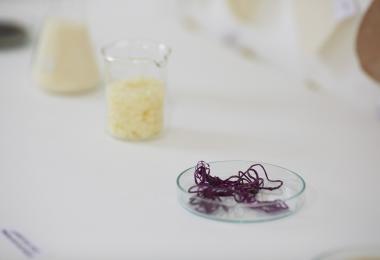
Scoby Science, 2018 - 2019
Katja Lonzeck
In an attempt to search for organic alternatives and the need to rethink our relationship with material consumption, this work explores a material that lasts within a single product life cycle; a material that is durable and self expiring; a material that is able to recreate itself nearly endlessly and doesn‘t require any finite resources.
By exploring the possibility of cultivated fungal and bacterial matter, a biological and sustainable material was developed that could be used to replace ecologically harmful artifacts.
© Amman Design Week 2019
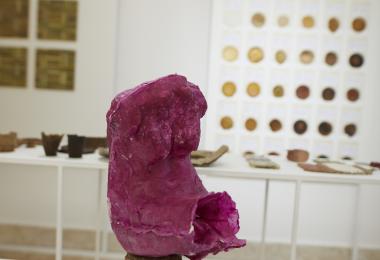
Rosemary, Kiss, Kill, 2019
Sama Shahrouri
A figurative work originally sculpted in clay then molded to create multiple bioplastic casts. This plaster sculpture showcases the original clay work of the designer, comparing it with the other bioplastic copies to highlight the different ways that multiple bioplastic recipes respond to form as their consistencies change.
© Amman Design Week 2019
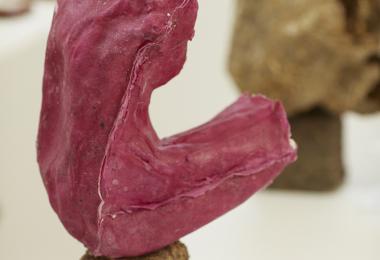
Rosemary, Kiss, Kill, 2019
Sama Shahrouri
A figurative work originally sculpted in clay then molded to create multiple bioplastic casts. This plaster sculpture showcases the original clay work of the designer, comparing it with the other bioplastic copies to highlight the different ways that multiple bioplastic recipes respond to form as their consistencies change.
© Amman Design Week 2019
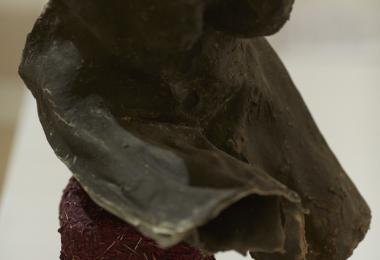
Rosemary, Kiss, Kill, 2019
Sama Shahrouri
This work is created using a mixture of rosemary sap and starch bioplastic. Sugar-free gelatin is used in the recipe to decrease the possibilities of growing mold within the work, while natural clay is used as a coloring element. During the drying process, the rosemary sap reacts to its surroundings by shrinking and deforming the original shape of the sculpture.
© Amman Design Week 2019
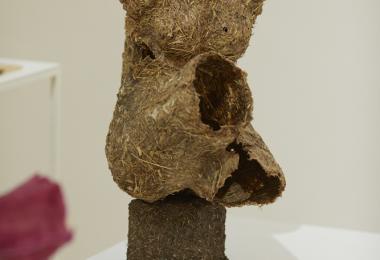
Rosemary, Kiss, Kill, 2019
Sama Shahrouri
By adding straw to a starch-based bioplastic recipe, the fibers help the mixture take shape and preserve form after drying. Little shrinking occurred in the drying process, thus creating the most truthful depiction of the original clay work.
© Amman Design Week 2019
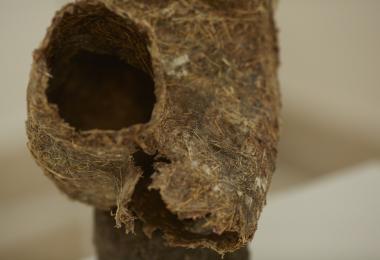
Rosemary, Kiss, Kill, 2019
Sama Shahrouri
By adding straw to a starch-based bioplastic recipe, the fibers help the mixture take shape and preserve form after drying. Little shrinking occurred in the drying process, thus creating the most truthful depiction of the original clay work.
© Amman Design Week 2019
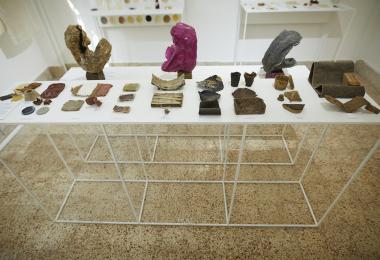
Made from Jordan, 2019
Twelve Degrees
These samples are the results of an 8-month exploration using a variety of locally sourced raw materials including clay, dead sea mud, tree resins, stone, minerals, oil mill waste, and scoby.
© Amman Design Week 2019
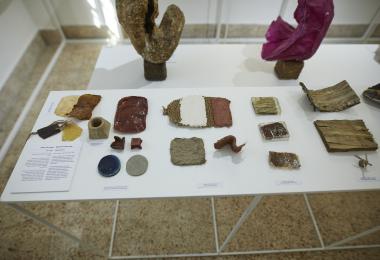
Made from Jordan, 2019
Twelve Degrees
These samples are the results of an 8-month exploration using a variety of locally sourced raw materials including clay, dead sea mud, tree resins, stone, minerals, oil mill waste, and scoby.
© Amman Design Week 2019
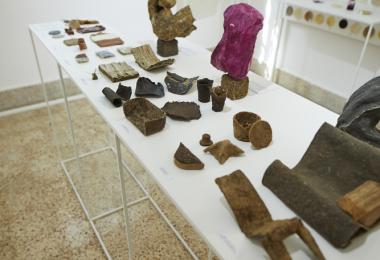
Made from Jordan, 2019
Twelve Degrees
These samples are the results of an 8-month exploration using a variety of locally sourced raw materials including clay, dead sea mud, tree resins, stone, minerals, oil mill waste, and scoby.
© Amman Design Week 2019
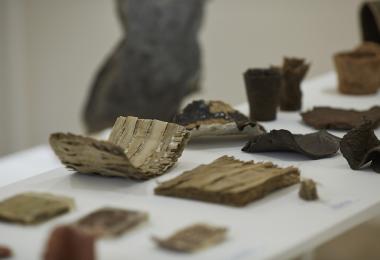
Made from Jordan, 2019
Twelve Degrees
These samples are the results of an 8-month exploration using a variety of locally sourced raw materials including clay, dead sea mud, tree resins, stone, minerals, oil mill waste, and scoby.
© Amman Design Week 2019
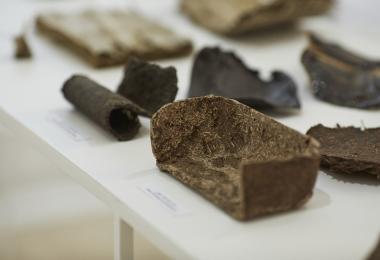
Made from Jordan, 2019
Twelve Degrees
These samples are the results of an 8-month exploration using a variety of locally sourced raw materials including clay, dead sea mud, tree resins, stone, minerals, oil mill waste, and scoby.
© Amman Design Week 2019
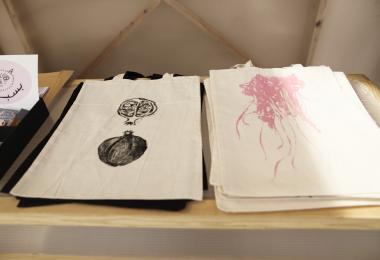
Basbous
Paper collection by Basbous
© Amman Design Week 2019
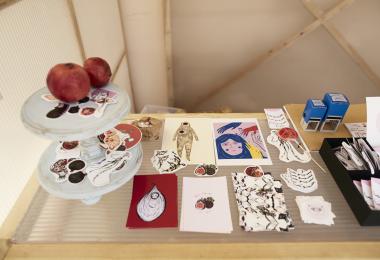
Basbous
Paper collection by Basbous
© Amman Design Week 2019
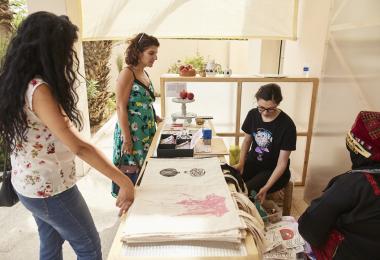
Basbous
Paper collection by Basbous
© Amman Design Week 2019
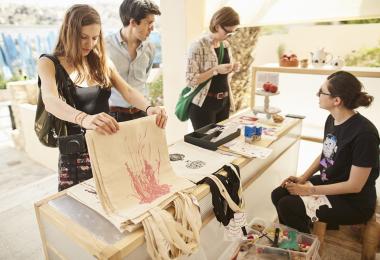
Basbous
Paper collection by Basbous
© Amman Design Week 2019
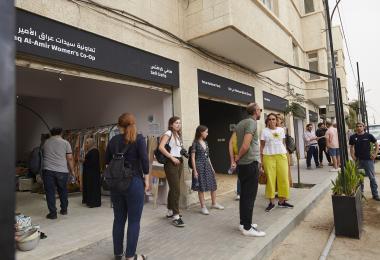
The Crafts District
Rihla ila alhiraf
The Crafts District 2019 took over the Kabariti Village in Jabal Amman and converted abandoned shop fronts to active spaces for crafts, bringing the act of making back to the street.
© Amman Design Week 2019
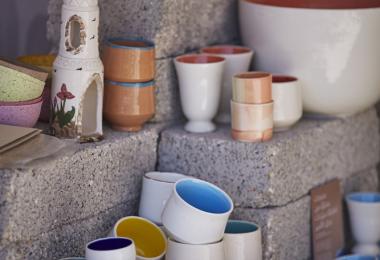
Iraq Al-Amir Women’s Co-op and Safi Crafts Shop
Iraq Al-Amir Women’s Co-op is a community of women who work in paper making, natural dyes, and ceramics.
© Amman Design Week 2019
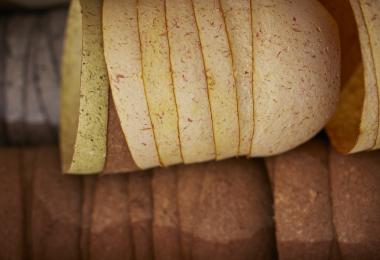
Iraq Al-Amir Women’s Co-op
Iraq Al-Amir Women’s Co-op is a community of women who work in paper making, natural dyes, and ceramics.
© Amman Design Week 2019

Safi Crafts
Safi Crafts is a women's collective based in the Jordan Valley who produce artisanal products ranging from scarves to bags, wallets, hijabs, t-shirts, and kaftans, and extend to home decor pieces and children’s clothing.
© Amman Design Week 2019
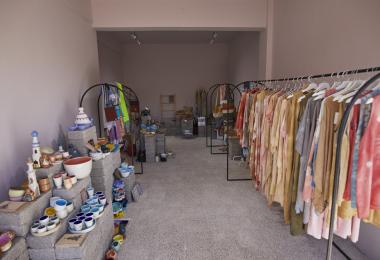
Iraq Al-Amir Women’s Co-op and Safi Crafts Shop
Safi Crafts is a women's collective based in the Jordan Valley who produce artisanal products ranging from scarves to bags, wallets, hijabs, t-shirts, and kaftans, and extend to home decor pieces and children’s clothing.
Iraq Al-Amir Women’s Co-op is a community of women who work in paper making, natural dyes, and ceramics.
© Amman Design Week 2019
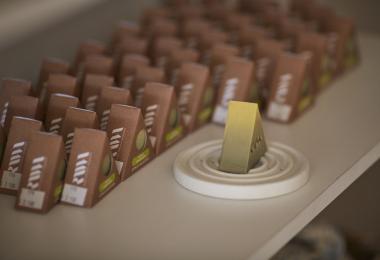
Irth Collective Shop
Irth Collective is a creative industries project that is aimed at creating a source of sustainable income and employment through the development of a range of high quality commercial product lines. These lines are created by international and local designers and product developers alongside the Women's associations across Jordan in Zarqa, Azraq, Ajloun, Wadi Rayyan, Umm El Jimal and Amman.
© Amman Design Week 2019
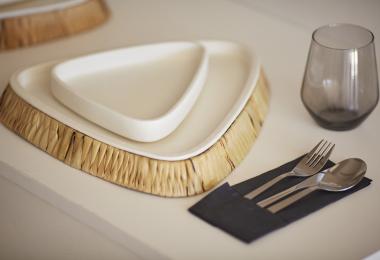
Irth Collective Shop
Irth Collective is a creative industries project that is aimed at creating a source of sustainable income and employment through the development of a range of high quality commercial product lines. These lines are created by international and local designers and product developers alongside the Women's associations across Jordan in Zarqa, Azraq, Ajloun, Wadi Rayyan, Umm El Jimal and Amman.
© Amman Design Week 2019
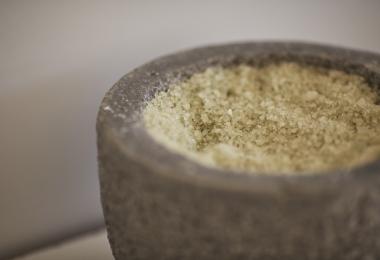
Irth Collective Shop
Irth Collective is a creative industries project that is aimed at creating a source of sustainable income and employment through the development of a range of high quality commercial product lines. These lines are created by international and local designers and product developers alongside the Women's associations across Jordan in Zarqa, Azraq, Ajloun, Wadi Rayyan, Umm El Jimal and Amman.
© Amman Design Week 2019
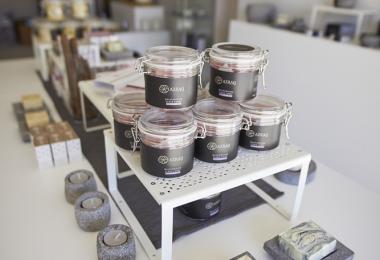
Irth Collective Shop
Irth Collective is a creative industries project that is aimed at creating a source of sustainable income and employment through the development of a range of high quality commercial product lines. These lines are created by international and local designers and product developers alongside the Women's associations across Jordan in Zarqa, Azraq, Ajloun, Wadi Rayyan, Umm El Jimal and Amman.
© Amman Design Week 2019
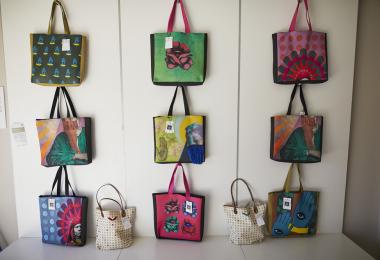
Irth Collective Shop
Irth Collective is a creative industries project that is aimed at creating a source of sustainable income and employment through the development of a range of high quality commercial product lines. These lines are created by international and local designers and product developers alongside the Women's associations across Jordan in Zarqa, Azraq, Ajloun, Wadi Rayyan, Umm El Jimal and Amman.
© Amman Design Week 2019
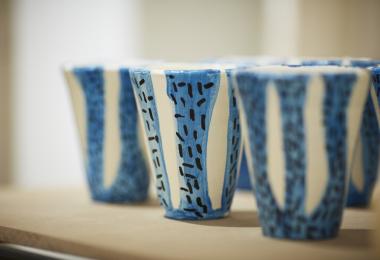
Microfund for Women Shop
Microfund for Women is a private non-profit organisation that envisions a more equal and just society in which women in particular are empowered to break the cycle of poverty, achieve prosperity and live inclusive lives. The products of these women range from high quality handicrafts, clay products, and embroidery.
These products were created through a mentorship program organized by Amman Design Week.
© Amman Design Week 2019
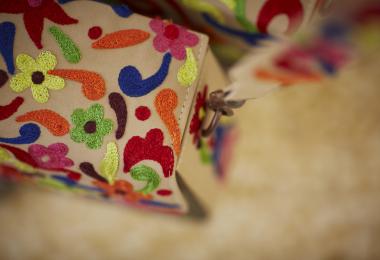
Microfund for Women Shop
Microfund for Women is a private non-profit organisation that envisions a more equal and just society in which women in particular are empowered to break the cycle of poverty, achieve prosperity and live inclusive lives. The products of these women range from high quality handicrafts, clay products, and embroidery.
These products were created through a mentorship program organized by Amman Design Week.
© Amman Design Week 2019
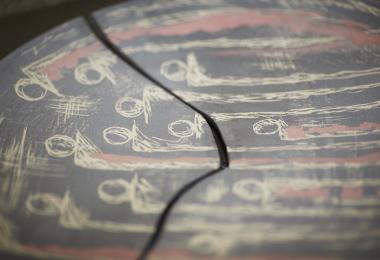
Microfund for Women Shop
Microfund for Women is a private non-profit organisation that envisions a more equal and just society in which women in particular are empowered to break the cycle of poverty, achieve prosperity and live inclusive lives. The products of these women range from high quality handicrafts, clay products, and embroidery.
These products were created through a mentorship program organized by Amman Design Week.
© Amman Design Week 2019
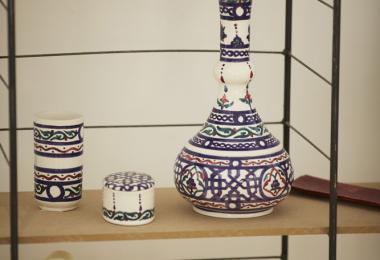
Microfund for Women Shop
Microfund for Women is a private non-profit organisation that envisions a more equal and just society in which women in particular are empowered to break the cycle of poverty, achieve prosperity and live inclusive lives. The products of these women range from high quality handicrafts, clay products, and embroidery.
These products were created through a mentorship program organized by Amman Design Week.
© Amman Design Week 2019
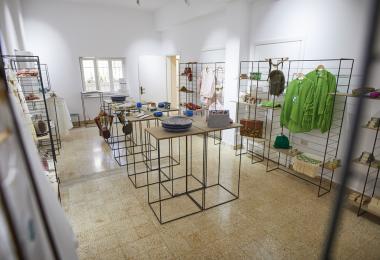
Microfund for Women Shop
Microfund for Women is a private non-profit organisation that envisions a more equal and just society in which women in particular are empowered to break the cycle of poverty, achieve prosperity and live inclusive lives. The products of these women range from high quality handicrafts, clay products, and embroidery.
These products were created through a mentorship program organized by Amman Design Week.
© Amman Design Week 2019
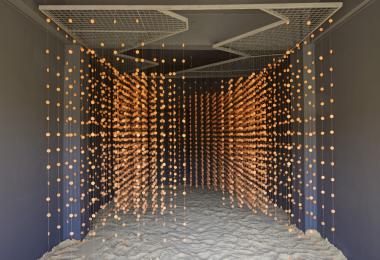
Sīk, 2019
Arini for Petra National Trust
Sīk is an abstraction of a journey that resembles a block, slowly taking shape from a more intact centre. As the passerby approaches the installation, Sīk reveals a path into its parts, emphasising the role of the journey in altering our perception of the object.
The clay coins used to create this spatial experience were produced as part of a continued collaboration between Petra National Trust (PNT) and Cambridge School through its community service program. Cambridge IB students volunteered their time and talents to the Cultural Heritage Program.
Photo by Edmund Sumner
© Amman Design Week 2019
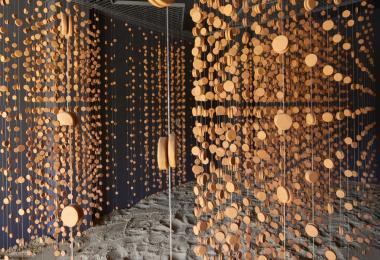
Sīk, 2019
Arini for Petra National Trust
Sīk is an abstraction of a journey that resembles a block, slowly taking shape from a more intact centre. As the passerby approaches the installation, Sīk reveals a path into its parts, emphasising the role of the journey in altering our perception of the object.
The clay coins used to create this spatial experience were produced as part of a continued collaboration between Petra National Trust (PNT) and Cambridge School through its community service program. Cambridge IB students volunteered their time and talents to the Cultural Heritage Program.
Photo by Edmund Sumner
© Amman Design Week 2019
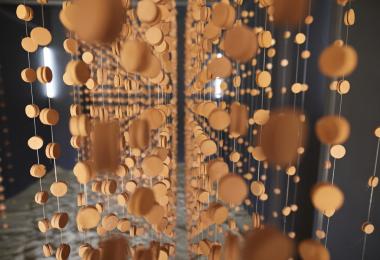
Sīk, 2019
Arini for Petra National Trust
Sīk is an abstraction of a journey that resembles a block, slowly taking shape from a more intact centre. As the passerby approaches the installation, Sīk reveals a path into its parts, emphasising the role of the journey in altering our perception of the object.
The clay coins used to create this spatial experience were produced as part of a continued collaboration between Petra National Trust (PNT) and Cambridge School through its community service program. Cambridge IB students volunteered their time and talents to the Cultural Heritage Program.
© Amman Design Week 2019
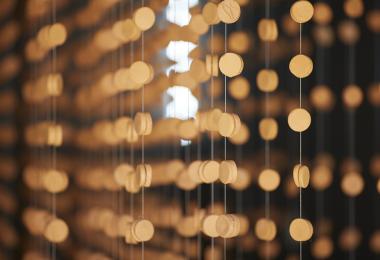
Sīk, 2019
Arini for Petra National Trust
Sīk is an abstraction of a journey that resembles a block, slowly taking shape from a more intact centre. As the passerby approaches the installation, Sīk reveals a path into its parts, emphasising the role of the journey in altering our perception of the object.
The clay coins used to create this spatial experience were produced as part of a continued collaboration between Petra National Trust (PNT) and Cambridge School through its community service program. Cambridge IB students volunteered their time and talents to the Cultural Heritage Program.
© Amman Design Week 2019
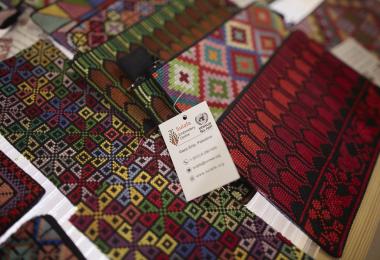
Sulafa Embroidery Centre Shop
Sulafa Embroidery Centre based in Gaza and was established in 1950 by UNRWA. Sulafa supports almost 300 local artisans through commissioning traditional and contemporary embroidered goods.
© Amman Design Week 2019
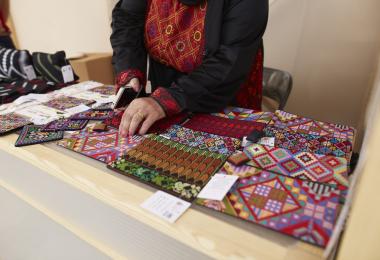
Sulafa Embroidery Centre Shop
Sulafa Embroidery Centre based in Gaza and was established in 1950 by UNRWA. Sulafa supports almost 300 local artisans through commissioning traditional and contemporary embroidered goods.
© Amman Design Week 2019
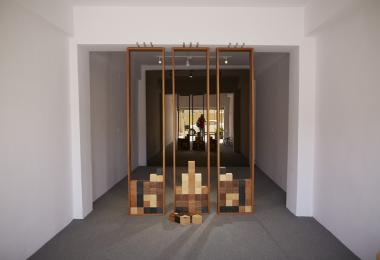
wehda
Turquoise Mountain
Unit, unity and isolation are among the various possible translations of “wehda” in Arabic. It reflects the realities of a craft and a community of artisans in displacement.
The intervention comprises three inherently connected elements: a temporary production workshop, an ongoing interactive installation, and a series of discussions taking place over the nine days of Amman Design Week.
wehda positions the craft of wood-mosaic at the center of the intervention. Wood-mosaic has a long history in the Levant and is of particular significance to artisans in Damascus. However, conflict and displacement in recent years have considerably disrupted the craft. Separated from their networks, some artisans moved to Jordan and other countries in the region where they have since been practising in a new ecosystem. Here, they attempt to recreate a community of practice and a sense of place.
Inspired by street-level workshop typologies, the intervention is an invitation to interact with the craft and its artisans while also celebrating the macro and micro aspects of design and production. wehda looks beyond displacement to explore and probe the possibilities that our local context can offer to craft practices.
© Amman Design Week 2019
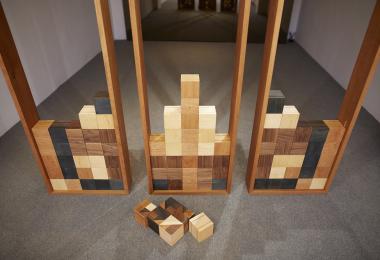
wehda
Turquoise Mountain
Unit, unity and isolation are among the various possible translations of “wehda” in Arabic. It reflects the realities of a craft and a community of artisans in displacement.
The intervention comprises three inherently connected elements: a temporary production workshop, an ongoing interactive installation, and a series of discussions taking place over the nine days of Amman Design Week.
wehda positions the craft of wood-mosaic at the center of the intervention. Wood-mosaic has a long history in the Levant and is of particular significance to artisans in Damascus. However, conflict and displacement in recent years have considerably disrupted the craft. Separated from their networks, some artisans moved to Jordan and other countries in the region where they have since been practising in a new ecosystem. Here, they attempt to recreate a community of practice and a sense of place.
Inspired by street-level workshop typologies, the intervention is an invitation to interact with the craft and its artisans while also celebrating the macro and micro aspects of design and production. wehda looks beyond displacement to explore and probe the possibilities that our local context can offer to craft practices.
© Amman Design Week 2019
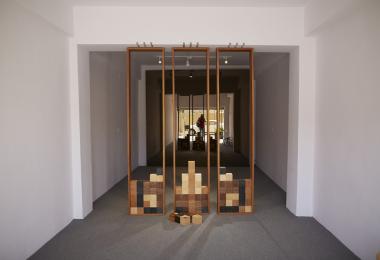
wehda
Turquoise Mountain
Unit, unity and isolation are among the various possible translations of “wehda” in Arabic. It reflects the realities of a craft and a community of artisans in displacement.
The intervention comprises three inherently connected elements: a temporary production workshop, an ongoing interactive installation, and a series of discussions taking place over the nine days of Amman Design Week.
wehda positions the craft of wood-mosaic at the center of the intervention. Wood-mosaic has a long history in the Levant and is of particular significance to artisans in Damascus. However, conflict and displacement in recent years have considerably disrupted the craft. Separated from their networks, some artisans moved to Jordan and other countries in the region where they have since been practising in a new ecosystem. Here, they attempt to recreate a community of practice and a sense of place.
Inspired by street-level workshop typologies, the intervention is an invitation to interact with the craft and its artisans while also celebrating the macro and micro aspects of design and production. wehda looks beyond displacement to explore and probe the possibilities that our local context can offer to craft practices.
© Amman Design Week 2019
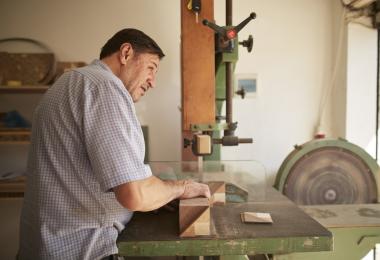
wehda
Turquoise Mountain
Unit, unity and isolation are among the various possible translations of “wehda” in Arabic. It reflects the realities of a craft and a community of artisans in displacement.
The intervention comprises three inherently connected elements: a temporary production workshop, an ongoing interactive installation, and a series of discussions taking place over the nine days of Amman Design Week.
wehda positions the craft of wood-mosaic at the center of the intervention. Wood-mosaic has a long history in the Levant and is of particular significance to artisans in Damascus. However, conflict and displacement in recent years have considerably disrupted the craft. Separated from their networks, some artisans moved to Jordan and other countries in the region where they have since been practising in a new ecosystem. Here, they attempt to recreate a community of practice and a sense of place.
Inspired by street-level workshop typologies, the intervention is an invitation to interact with the craft and its artisans while also celebrating the macro and micro aspects of design and production. wehda looks beyond displacement to explore and probe the possibilities that our local context can offer to craft practices.
© Amman Design Week 2019
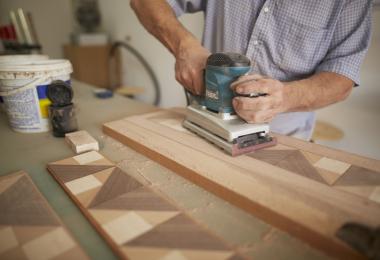
wehda
Turquoise Mountain
Unit, unity and isolation are among the various possible translations of “wehda” in Arabic. It reflects the realities of a craft and a community of artisans in displacement.
The intervention comprises three inherently connected elements: a temporary production workshop, an ongoing interactive installation, and a series of discussions taking place over the nine days of Amman Design Week.
wehda positions the craft of wood-mosaic at the center of the intervention. Wood-mosaic has a long history in the Levant and is of particular significance to artisans in Damascus. However, conflict and displacement in recent years have considerably disrupted the craft. Separated from their networks, some artisans moved to Jordan and other countries in the region where they have since been practising in a new ecosystem. Here, they attempt to recreate a community of practice and a sense of place.
Inspired by street-level workshop typologies, the intervention is an invitation to interact with the craft and its artisans while also celebrating the macro and micro aspects of design and production. wehda looks beyond displacement to explore and probe the possibilities that our local context can offer to craft practices.
© Amman Design Week 2019
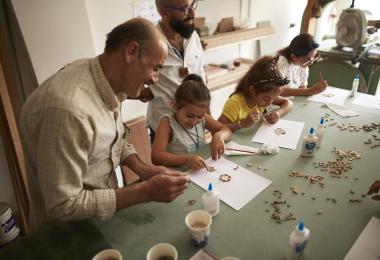
wehda
Turquoise Mountain
Unit, unity and isolation are among the various possible translations of “wehda” in Arabic. It reflects the realities of a craft and a community of artisans in displacement.
The intervention comprises three inherently connected elements: a temporary production workshop, an ongoing interactive installation, and a series of discussions taking place over the nine days of Amman Design Week.
wehda positions the craft of wood-mosaic at the center of the intervention. Wood-mosaic has a long history in the Levant and is of particular significance to artisans in Damascus. However, conflict and displacement in recent years have considerably disrupted the craft. Separated from their networks, some artisans moved to Jordan and other countries in the region where they have since been practising in a new ecosystem. Here, they attempt to recreate a community of practice and a sense of place.
Inspired by street-level workshop typologies, the intervention is an invitation to interact with the craft and its artisans while also celebrating the macro and micro aspects of design and production. wehda looks beyond displacement to explore and probe the possibilities that our local context can offer to craft practices.
© Amman Design Week 2019
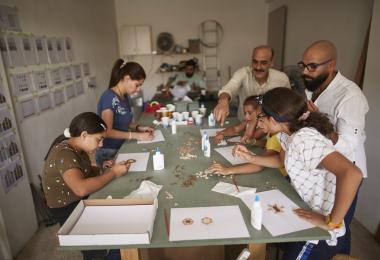
wehda
Turquoise Mountain
Unit, unity and isolation are among the various possible translations of “wehda” in Arabic. It reflects the realities of a craft and a community of artisans in displacement.
The intervention comprises three inherently connected elements: a temporary production workshop, an ongoing interactive installation, and a series of discussions taking place over the nine days of Amman Design Week.
wehda positions the craft of wood-mosaic at the center of the intervention. Wood-mosaic has a long history in the Levant and is of particular significance to artisans in Damascus. However, conflict and displacement in recent years have considerably disrupted the craft. Separated from their networks, some artisans moved to Jordan and other countries in the region where they have since been practising in a new ecosystem. Here, they attempt to recreate a community of practice and a sense of place.
Inspired by street-level workshop typologies, the intervention is an invitation to interact with the craft and its artisans while also celebrating the macro and micro aspects of design and production. wehda looks beyond displacement to explore and probe the possibilities that our local context can offer to craft practices.
© Amman Design Week 2019
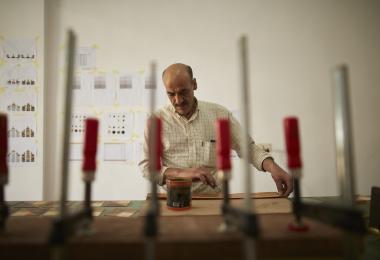
wehda
Turquoise Mountain
Unit, unity and isolation are among the various possible translations of “wehda” in Arabic. It reflects the realities of a craft and a community of artisans in displacement.
The intervention comprises three inherently connected elements: a temporary production workshop, an ongoing interactive installation, and a series of discussions taking place over the nine days of Amman Design Week.
wehda positions the craft of wood-mosaic at the center of the intervention. Wood-mosaic has a long history in the Levant and is of particular significance to artisans in Damascus. However, conflict and displacement in recent years have considerably disrupted the craft. Separated from their networks, some artisans moved to Jordan and other countries in the region where they have since been practising in a new ecosystem. Here, they attempt to recreate a community of practice and a sense of place.
Inspired by street-level workshop typologies, the intervention is an invitation to interact with the craft and its artisans while also celebrating the macro and micro aspects of design and production. wehda looks beyond displacement to explore and probe the possibilities that our local context can offer to craft practices.
© Amman Design Week 2019
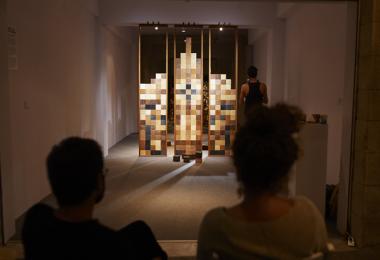
wehda
Turquoise Mountain
© Amman Design Week 2019
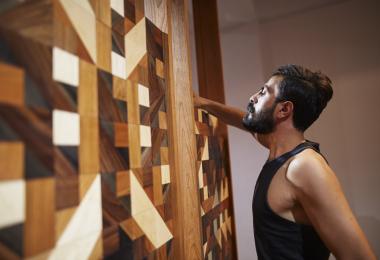
wehda
Turquoise Mountain
Unit, unity and isolation are among the various possible translations of “wehda” in Arabic. It reflects the realities of a craft and a community of artisans in displacement.
The intervention comprises three inherently connected elements: a temporary production workshop, an ongoing interactive installation, and a series of discussions taking place over the nine days of Amman Design Week.
wehda positions the craft of wood-mosaic at the center of the intervention. Wood-mosaic has a long history in the Levant and is of particular significance to artisans in Damascus. However, conflict and displacement in recent years have considerably disrupted the craft. Separated from their networks, some artisans moved to Jordan and other countries in the region where they have since been practising in a new ecosystem. Here, they attempt to recreate a community of practice and a sense of place.
Inspired by street-level workshop typologies, the intervention is an invitation to interact with the craft and its artisans while also celebrating the macro and micro aspects of design and production. wehda looks beyond displacement to explore and probe the possibilities that our local context can offer to craft practices.
© Amman Design Week 2019
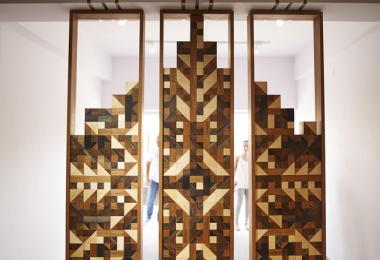
wehda
Turquoise Mountain
Unit, unity and isolation are among the various possible translations of “wehda” in Arabic. It reflects the realities of a craft and a community of artisans in displacement.
The intervention comprises three inherently connected elements: a temporary production workshop, an ongoing interactive installation, and a series of discussions taking place over the nine days of Amman Design Week.
wehda positions the craft of wood-mosaic at the center of the intervention. Wood-mosaic has a long history in the Levant and is of particular significance to artisans in Damascus. However, conflict and displacement in recent years have considerably disrupted the craft. Separated from their networks, some artisans moved to Jordan and other countries in the region where they have since been practising in a new ecosystem. Here, they attempt to recreate a community of practice and a sense of place.
Inspired by street-level workshop typologies, the intervention is an invitation to interact with the craft and its artisans while also celebrating the macro and micro aspects of design and production. wehda looks beyond displacement to explore and probe the possibilities that our local context can offer to craft practices.
© Amman Design Week 2019
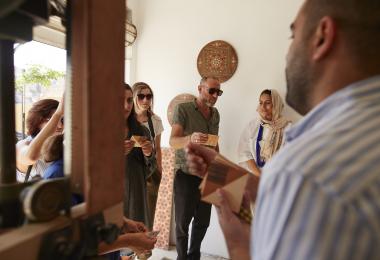
wehda
Turquoise Mountain
Unit, unity and isolation are among the various possible translations of “wehda” in Arabic. It reflects the realities of a craft and a community of artisans in displacement.
The intervention comprises three inherently connected elements: a temporary production workshop, an ongoing interactive installation, and a series of discussions taking place over the nine days of Amman Design Week.
wehda positions the craft of wood-mosaic at the center of the intervention. Wood-mosaic has a long history in the Levant and is of particular significance to artisans in Damascus. However, conflict and displacement in recent years have considerably disrupted the craft. Separated from their networks, some artisans moved to Jordan and other countries in the region where they have since been practising in a new ecosystem. Here, they attempt to recreate a community of practice and a sense of place.
Inspired by street-level workshop typologies, the intervention is an invitation to interact with the craft and its artisans while also celebrating the macro and micro aspects of design and production. wehda looks beyond displacement to explore and probe the possibilities that our local context can offer to craft practices.
© Amman Design Week 2019
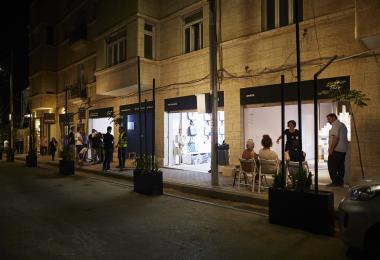
Kabariti Village
The Crafts District
The Crafts District 2019 took over the Kabariti Village in Jabal Amman and converted abandoned shop fronts to active spaces for crafts, bringing the act of making back to the street.
© Amman Design Week 2019
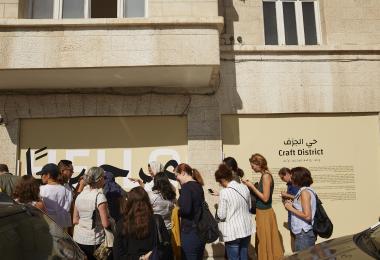
Kabariti Village
The Crafts District
The Crafts District 2019 took over the Kabariti Village in Jabal Amman and converted abandoned shop fronts to active spaces for crafts, bringing the act of making back to the street.
© Amman Design Week 2019
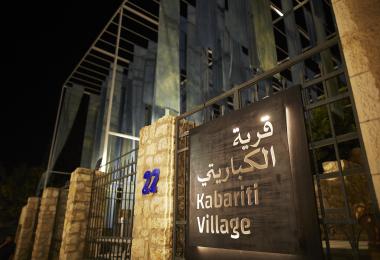
Kabariti Village
The Crafts District
The Crafts District 2019 took over the Kabariti Village in Jabal Amman and converted abandoned shop fronts to active spaces for crafts, bringing the act of making back to the street.
© Amman Design Week 2019

